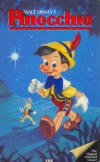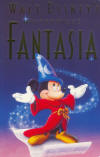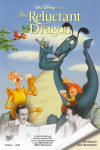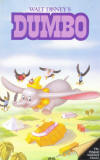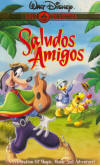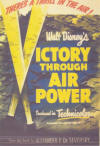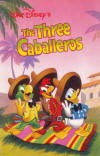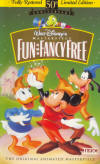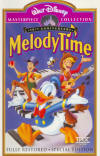November 14, 2009. (Note to readers: Lee and I have decided to make our way through my collection of every Walt Disney animated feature. (Sadly, they’re all on VHS tape, and may not be playable in 20 years.) We are going to watch one every Saturday until we get to Home on the Range. I’m not sure if Who Framed Roger Rabbit?, Chicken Little, Enchanted, and Meet the Robinsons qualify. Archivists differ on that. They also disagree as to whether Victory Through Air Power, So Dear to My Heart, Mary Poppins, Bedknobs and Broomsticks, Pete’s Dragon, and Song of the South qualify, since they are only partially animated, but I’m going to take the liberal interpretation and include them. Counting them that way, it turns out there are 52 features, so we should be finishing up around this time next year. Saturday Night at the Toons! It should be fun!)
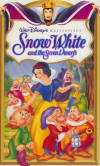 Snow White and the Seven
Dwarfs
Snow White and the Seven
Dwarfs
Random thoughts: The names of the dwarfs seem inevitable today, but they considered almost 50 of them, including Jumpy, Deafy, Dizzey, Hickey, Wheezy, Baldy, Gabby, Nifty, Sniffy, Swift, Lazy, Puffy, Stuffy, Tubby, Shorty and Burpy. Names that weren’t considered: Farty, Swishy (the gay dwarf), Boopsie (the girl dwarf), Flopsy, Mopsy, Snotty, Tubby, and George W.
It probably couldn’t be made today. Dopey is obviously retarded. Making fun of the developmentally disabled is a no-no.
Why do Snow White and the Queen have 8 fingers and two thumbs, while all the dwarfs have only 6 fingers? Are they a separate species?
Adrianna Casellotti’s supersonic soprano singing of Snow White’s songs was very much of its time, and is by far the worst thing in watching this movie today. When she warbles “And the birds will siiiiiiiing!” be sure to put the dog out and protect all your crystal and crockery. IMDb.com (1940) Of all the early Disney animated features, I think this is the best. (I put Fantasia in a class by itself.) Oddly, at least from today’s perspective, it wasn’t a big success at the time. Some of that had to do with the War, which prevented an overseas release. But the reviews were mostly mixed. It took a while for Walt to recoup his $2,289,000 investment. With Fantasia’s lack of success immediately following, things were looking grim for Disney Studios for a while there. Today, of course, it is an acknowledged masterpiece, some say the best use of hand-drawn animation ever. It made even more use of the multi-plane camera than Snow White and the Seven Dwarfs did. That is a thing invented on the Disney lot by Ub Iwerks, a vertical arrangement of glass panes upon which scenery could be drawn from various distances and moved at different rates, so that things in the foreground went past the field of view faster than things in the background. The Disney multi-plane had seven levels, and they were able to achieve an amazing illusion of depth with it.For most of the last half of the 20th Century, the Disney animated features were re-released theatrically every seven years, something no other studio was ever able to do, and which went a long ways toward keeping the studio in the black. It was pretty much a guaranteed audience. Thus, Pinocchio eventually brought in $84 million. Not bad for a little wooden head! Looking at the release dates, I figure I must have seen it in 1954. I recall it very well. It was at the Palace Theater in Corsicana, Texas. I was seven. And let me tell you, when Monstro the Whale started chasing Pinocchio, Gepetto, and Jiminy Cricket, I was scared! It’s the first time I recall being scared at the movies. I didn’t mind; I’m not the nightmare kind, things like that don’t haunt me or disturb my sleep. In fact, I enjoyed the hell out of it.
I’ve never read the book this movie was based on, but it should come as no surprise that Disney tinkered with it, a lot. And with good reason. I’ve read about the book, and it sounds just awful! Certainly not good material for children … and, of course, it was not written primarily for children. It was an allegory, and in the first version, Pinocchio is hanged! Collodi then added a sort of “Further adventures of,” and it became popular with both adults and children. Some of the changes were inconsequential, as turning the Giant Dogfish into Monstro the Whale. The Fox and the Cat were rogues in both versions. There was a puppet show, and a place like Pleasure Island where boys turned into donkeys (mules, actually). But Gepetto didn’t like children. He never asked for a little wooden boy, he was given a magic log that talked, and carved a boy out of that. And Pinocchio … he was a friggin’ juvenile delinquent! First thing he did when he came alive, he kicked Gepetto. He threw something at the talking cricket, and killed it! (The cricket’s ghost came back in later installments.) And the Blue Fairy had a much larger part to play than merely bringing him to life and saving his bacon when he was in a cage. None of this matters to me. I approve of all the changes they made. I just thought it was interesting.
We always look for odd names in the credits. The champ here is one T. Hee. I’d seen his name before, he did a lot of animation work from the ‘30s to the ‘60s. But you just gotta love the name, don’t you? IMDb.com (1940) This has to be one of the most amazing films ever made. Almost 70 years later, in this age of CGI, it still has the capacity to astonish. It is even more mind-boggling when you consider the intensive labor and sheer innovation needed to bring some of the effects seen here to the screen. And it was a case of Walt Disney being far ahead of his time, because it was not a financial success when it was made. Because it was so expensive, its production put Walt and his studio in jeopardy for most of the 1940s. It didn’t get into the black until 1969.Music critics were for the most part not too enthralled with the whole idea. Some were offended that great music was abridged (the Beethoven symphony is half its concert length); some just thought it was a dumb idea to put moving images to familiar music. I think we can say now that the critics were wrong, though the choices made to illustrate some of the music can still be debated. I guess it will be a matter of personal taste as to which of the eight segments you like best. Here’s my take on them:
Johann Sebastian Bach – Toccata and Fugue in D Minor. I’ve sometimes wondered if Walt made a mistake in putting this completely abstract piece right up there at the beginning. After a brief introduction by Deems Taylor, the orchestra itself is shown—quite artfully, with amazing colors swelling up with the music—and then the orchestra becomes abstracted, with the tips of violin bows moving geometrically across the screen, and finally the shapes become completely abstract. Also, this piece probably offended purists because it was written for organ, and performed, like seven of the eight pieces, by the Philadelphia Orchestra under the baton of Leopold Stokowski, whose enthusiasm for Walt’s idea was apparently a big factor in the film being made at all. For myself, I’d put it in the middle range of the eight, neither the best nor the worst.
I first saw Fantasia in its third re-release, in 1969. People were dropping acid before they went into the theater. That never appealed to me; the power of acid, I always felt, was that it could make the real world look like Fantasia. I had heard about it for a long time, and had seen portions of it here and there, on the Disney TV show, and saw the Rite of Spring part in a school AV presentation, maybe in the 5th grade.
(Note: When my family got our first stereo—a monster piece of wooden furniture with 15-inch woofers at each end—the first LP I bought was the legendary Mercury recording of Tchaikovsky’s 1812 Overture by Antal Doráti and the Minneapolis Symphony, the first version (I think) to use actual cannons and carillon. (I think my Mom would have been happier if I’d bought something quieter; our house reverberated with cannon fire for weeks afterward.) The recording was so revolutionary that Deems Taylor was brought in to explain how it was all done. So I view old Deems as a good friend.)
Pyotr Ilyich Tchaikovsky – Nutcracker Suite. I wish they had included the “Overture” and “March,” but aside from that, this is one of my favorites. The four seasons are interpreted with very skinny fairies making plants sprout, flourish, wither, and freeze. It goes from the “Dance of the Sugar Plum Fairy” to the “Waltz of the Flowers,” and it enchants me every time.
Paul Dukas – The Sorcerer's Apprentice. Everybody’s favorite. How can you resist? I understand that one reason it was done was to re-invigorate Mickey Mouse, who had been losing popularity to Donald Duck. I don’t know if it worked—I’ve always preferred the Duck to the Mouse—but he shines here. And this is clearly a piece that tells a story.
Igor Stravinsky – The Rite of Spring. Probably the most impressive segment, to me. It was a pretty gutsy move to include this, as it was still controversial. Believe it or not, there was a riot when this ballet was first performed in Paris in 1913. (Can you imagine? Riot? What the hell, was there a mosh pit in front of the stage?) Disney’s version is nothing less than the creation of the solar system, and the evolution of life, culminating in the extinction of the dinosaurs. (And no, Sarah Palin, there weren’t any cavemen hunting the dinos, 6000 years ago, shortly after the Creation.) Sadly, I imagine this part of the movie would still be controversial today in some shit-for-brains quarters, because it shows evolution, though it stops short of positing man’s descent from apes.
Intermission/Meet the Soundtrack. A trifle, but an entertaining one. The soundtrack movies away from its invisible place at the side of the film, and shows fanciful interpretations of what various instruments might look like. There is also a brief jam session with the orchestra members. This seems like a good place to mention something I noticed early on in the orchestra: A contrabassoon. But what a contrabassoon! The ones I’ve seen are indeed large—it’s a deep-throated instrument—but this one is gigantic. It towers over everybody else. It’s a good thing somebody figured out how to fold it up a bit. You’d have needed a ladder to service the keys at the top. Also, I wonder if the Philadelphia Orchestra brass section really used Sousaphones? These were designed for marching bands, so you could rest them on your shoulder. Every symphony I’ve ever seen employed traditional tubas. I suspect it was a visual choice rather than reality.
Ludwig van Beethoven – Symphony No. 6 in F. One of my favorites. It might even have been my inspiration for the titanides in my Gaea Trilogy. Maybe some of it is overly cutesy, in particular the sexless cupids, but the centaurs are undeniably sexy. There has been some controversy over the brief appearance of two “African” centaurs accompanying Bacchus. They have zebra lower halves, and are clearly functioning as servants. That’s too bad, but it was standard for the day. And if there were black centaurs, it would make sense for them to be half zebra. (Late note: I just learned that in the original version there was a character called Sunflower, a black centaur, who waited on the female centaurs. This is a lot more offensive … and we’ll probably never see her again, as she was edited out of the film for the 1969 release. I despise this sort of historical revisionism, I think racism in a 1940 film should be used as a “teachable moment” rather than Bowdlerized. All Disney animated films have also been edited to remove scenes where characters were smoking—or, in “Pecos Bill,” just the cigarettes have been digitally removed, making for some very odd behavior … but don’t get me started on that.)
Amilcare Ponchielli – La Gioconda: Dance of the Hours. Easily my least favorite. It’s funny, no question, but hippos in tutus is not really my bag. Also, I have never particularly liked this music, and it must be mentioned that no one of my generation will ever be able to hear it without singing “Hello Muddah, Hello Faddah,” the silly little hit by Allan Sherman, any more than most of us can hear the William Tell Overture without thinking of the Lone Ranger.
Modest Mussorgsky – Night on Bald Mountain and Franz Schubert – Ave Maria. This one is (in my opinion) an unfortunate matching of one of the very best segments with the most boring one. I don’t really care for the Ave Maria in the first place, and the reverence and very slow pace here struck me as the wrong way to end the picture. But the first part … Wow! If I’d seen the demon Chernabog when I was a child, I’m sure I would have had nightmares. And Disney, after chickening out when it came to nipples on female centaurs, included them on some really, really ugly demons here. IMDb.com (1941) Except for Victory Through Air Power, this is the least known of the Disney animated features. (I am using the broader definition, to include the films which were only partly animated, such as Mary Poppins.) Only the last part of the film, the “Reluctant Dragon” short itself, is widely available, paired with “Morris, the Midget Moose” on a Mini-Classics VHS tape. But in 2002 it was released in its full-length version on the DVD Walt Disney Treasures: Behind the Scenes at the Disney Studio. WDTs are sets that come in neat metal boxes and are not sold in video stores; you can get them only through Disney, and they each have a limited run. They are archival (The Complete Mickey; The Complete Goofy; The Silly Symphonies; etc.) or consist of stuff from deep in the celebrated Disney Vaults, stuff from the TV show, the Mickey Mouse Club; obscure things that only a Disneyphile would be interested in. I have a few of them, including this one.It was made, along with Dumbo, as a cheap way of getting customers into the theaters after the financial disasters of Pinocchio and Fantasia, with the studio in deep trouble. It came out during the 5-week strike, when tempers were high. And it was a financial failure, too. If not for the big success of Dumbo later in the year, Disney might not have made it. People expected another feature-length tale, and felt cheated by this one. I can see their point, but it looks entirely different today. It’s a valuable look back at the studio when it was still young, and I like it a lot.
The schtick is that Robert Benchley is prevailed upon by his wife to take this little story by Kenneth Grahame (also the author of The Wind in the Willows) and pitch it to Walt. Bob isn’t enthusiastic. He is met at the studio gate by Humphrey, a studio guide apparently recruited from Mussolini’s Brown Shirts. The dude is seriously stern, regimented, and humorless; he even dresses like a Hitler Youth. Benchley spends most of the rest of the picture avoiding him, and as a result ducks into most of the studio’s departments and is, conveniently, shown how everything works by amazingly accommodating employees. This is fascinating stuff, and some of it is even accurate. In each department someone draws or sculpts a caricature of him. In the art department they are drawing elephants from a real elephant model. In the sound department he meets Clarence Nash, the voice of Donald Duck, and Florence Gill, who imitates a chicken singing. Then he goes to the Foley department, where sound effects are being added to a concept animation of Casey, Jr., the little train in Dumbo, the second reference (after the real elephant) to the other movie being produced at the studio as this one was being filmed.
When he enters the photography department the film switches from black and white to color, a la The Wizard of Oz, only Benchley notices the transition, saying, “Oh, Technicolor!” and examining his tie. Cute. We see the fabled multi-plane camera in use and then move on to Ink & Paint, a very nice and wildly colorful segment showing how the paints are made and then applied to the cels. And who should appear in the cel but little Bambi, who would be appearing in theaters about a year later.
In the maquette department there is a table crowded with foot-high concept sculptures, and I was amazed to see not only Captain Hook and Tinkerbell, basically as they would later appear in the movie, but the twin Siamese cats from Lady and the Tramp. What is amazing about that is that Peter Pan would not reach theaters until 1953, and the mutts until 1955, 14 years later! Sometimes ideas percolated around the studio for quite a long time before they were fully developed. That, and WWII intervened and disrupted normal studio activities such that they didn’t produce another single-story, feature-length animation until Cinderella in 1950. In this department Benchley filches a maquette of what appears to be Sunflower, the black servant centaurette from Fantasia, now, alas, excised from the film and consigned to the waste heap of political correctness.
Then we move to the story department, the best part of the movie. The writer-animators (three of whom are played by themselves) want to try out an idea on Benchley, telling it via a storyboard that covers an entire wall. The story is “Baby Weems,” legendary among animation fans, and available only here on this obscure DVD. It is a wonderful and innovative use of extremely limited animation. There is very little motion as we segue from the man pointing to the drawings to the story itself. It is basically a series of still drawings with one or two animated elements. This doesn’t sound all that interesting, but trust me, it is just amazing. You have to see it to appreciate it, and unfortunately, it is so firmly embedded in this movie that it wouldn’t make sense to take it out and make an independent release of it, so it will probably continue to be seen only by the likes of me.
(Amusing detail: the guy who climbs up on a box to start telling the story—because the upper left-hand corner is almost at the ceiling—is none other than Alan Ladd! He toiled in mostly uncredited bit parts—including Citizen Kane—for over a decade before hitting it big in This Gun For Hire. Lee observed that even in a cartoon he had to stand on a box. In case you didn’t know, Ladd was 5’4” and usually had to stand on a box when kissing his leading lady, so he could look down on her.)
So that’s the second animated segment. The third is “How to Ride a Horse,” the first of the fabulous Goofy “How to” series. Introducing the short are three real Disney animators: Ward Kimball, Fred Moore, and Norm Ferguson.
At last Humphrey catches Bob and takes him to a screening room, where he meets a very young Walt and they watch the newest Disney film, which turns out to be, naturally, “The Reluctant Dragon.” Oddly, I found this last part the least interesting bit in the movie. The story is not very interesting and drags here and there, the animation is lackluster, and the dragon is portrayed as a very effeminate stereotyped gay. There is little to root for and little to laugh at.
I am not one of those who is apt to complain that Disney has screwed around with the source material, as so many do, possibly because, in most cases, I haven’t read the source material. So I don’t care if Mary Poppins is too sweet; I never read the book. But I did read all the Pooh books, and didn’t care for the Disney version, so maybe the detractors have a point. I do sort of wonder if this short story had more to recommend it than what made it to the screen. IMDb.com (1941) In 1941 the Disney Studios were in trouble from two financial failures in a row, Pinocchio and Fantasia, films that would go on to be regarded as classics but that didn’t bring in that much at the box office. They needed some hits, and they needed them now, and they needed them cheap. The first attempt was another failure: The Reluctant Dragon. The second was a box office smash: Dumbo.To make the little elephant with the big ears they cut costs, but they didn’t cut quality. The film runs only 62 minutes (distributors were appalled, and wanted it to either be made longer or cut down and paired with another short). They made sure they had a powerful story with good characters, and then they simplified the art work. This is noticeable only if you compare it with the amazing detail in its three predecessors. There is an abstractness to the backgrounds, and the character drawings don’t have the depth of, say, Snow White. They managed to turn these deficits into strengths. The movie looks just wonderful. And when they really pulled out all the stops, it is stunning. There’s a scene with a lot of clowns seen only as shadows cast on a tent wall that is just brilliant. The night scenes of erecting the Big Top are striking, as well. And the freak-out of “Pink Elephants on Parade” floors me anew every time I see it. Walt once briefly worked with Salvador Dali. Nothing much came of it, but when I see this sequence I always think, “Who needs Dali?” People loved this movie. Critics did, too, and saw it as a return to the Disney roots after the rather highfalutin’ artiness of Fantasia. It was the first Disney movie to be released on that new invention, home videotape, in 1981.
And once again charges of racism rear their ugly heads. I guess an argument can be made, but I’m not sympathetic to it. The five black crows who discover Dumbo up in a tree do speak in broad Negro accents, but you can’t deny the accents are authentic, and they do laugh a lot, but they are no Stepin Fetchits. They are smart, and funny, and they sing a very clever jazz song with a lot verbal humor. And in the end they are the only ones, other than Timothy Mouse, who don’t ostracize Dumbo, but help him. And I think it’s funny that—though this doesn’t appear in the credits—the boss is named Jim Crow. Compare these crows with other portrayals of black people in 1941 and I think most people would agree that it is much better than average. IMDb.com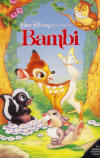 Bambi
(1942) This movie contains some of
the best animation Disney ever produced; hell, some of the best
anyone has ever produced. Current CGI technology can make
photo-real images of incredible complexity, but it takes an artistic
hand, not a computer, to come up with the images, and no computer
can by itself decide to use less detail, and few
humans today would think of it. After all, we can make it real.
What could be better than that? Well, painters could make it real
earlier than Rembrandt. The genius of the Impressionists was to
realize that sometimes being less real is more
evocative than reality. Much of Bambi is impressionistic: soft focus
watercolors, backgrounds that bleed into each other, minimal
brushstrokes that tell more than detail ever could. Against these
backgrounds—or sometimes in the middle of them, thanks to the
multi-plane camera—the sharply-drawn characters are shown to their
best advantage.
Bambi
(1942) This movie contains some of
the best animation Disney ever produced; hell, some of the best
anyone has ever produced. Current CGI technology can make
photo-real images of incredible complexity, but it takes an artistic
hand, not a computer, to come up with the images, and no computer
can by itself decide to use less detail, and few
humans today would think of it. After all, we can make it real.
What could be better than that? Well, painters could make it real
earlier than Rembrandt. The genius of the Impressionists was to
realize that sometimes being less real is more
evocative than reality. Much of Bambi is impressionistic: soft focus
watercolors, backgrounds that bleed into each other, minimal
brushstrokes that tell more than detail ever could. Against these
backgrounds—or sometimes in the middle of them, thanks to the
multi-plane camera—the sharply-drawn characters are shown to their
best advantage.
Not a lot really happens in Bambi, which had to be a risky decision. Bambi is born. He frolics with his little friends. The seasons change. His mothers dies … wait a minute, did I hear you right? His mother dies? Shot dead by a human hunter? In a film for children? Talk about risky decisions! (I just learned that, originally, they were going to show the mother lying dead in a pool of blood. What were they smoking when they came up with that?)
Much has been written, pro and con, as to whether Bambi is a suitable film for children, as most would agree that the death of your mother is miles scarier than all the phony spooks and goblins Hollywood has ever produced. I’ve vacillated on the subject. I’m pretty sure that it’s too intense for some younger children, but I’m not sure what the cut-off age is. I must have seen it in its third release, in 1957, which means I was 10. I don’t remember if I cried or not, but if I didn’t, it was because 10-year-old boys aren’t supposed to cry and I was holding it back. Because I’m sure I wanted to cry. But I didn’t have nightmares about it, and I can’t see that it’s done me any permanent damage. Would it have harmed me at age 5? I doubt it. I think children are pretty resilient.
I remember being awed and a bit frightened by the forest fire at the end, but I had forgotten about the dogs. How could I have forgotten about the dogs? They were really frightening!
Some random thoughts:
Re: Thumper. I recall that my sisters and I loved Thumper. “If you can’t say anything nice, don’t say nothin’ at all.” Well, sorry, Thump ol’ boy, I can’t say anything nice about you today. I found him insufferable. But I remember that I did love him, and I’ll bet young children still do today, so I’m not complaining.
Predators: I know it’s a cartoon universe, but most of the animals are so realistically drawn here that it just drives it home all the stronger how insane it all is. There’s a scene of an owl waking up a chipmunk and shooing it away. Hello!!! Owls eat chipmunks! He was shooing away his breakfast! I’ve always been a little pissed off that predators are almost always cast as the bad guys. Hey, they’re part of the big Circle of Life! There’s nothing wrong with eating meat. I would hope that even a vegan would realize that a crocodile or a wolf is only making a living, same as Ingrid Newkirk, in the only way Great Nature has adapted it to. But when we get a predator as hero, as in The Lion King, we get the ridiculous idea that he decides to eat worms and maggots and grubs. Hey! You think maggots don’t have feelings? Just ask George W. Bush. Or in Madagascar they solve the dilemma by eating fish. Which one, I wonder? Pinocchio’s Cleo, or Nemo?
Mating: This is a very small gripe, and as I said, it’s a cartoon universe, and animals are anthropomorphized, that’s what cartoons are about … but somebody should tell Faline that after Bambi has vanquished his rival for her affections, expect to have at least a dozen more females for company in his harem … IMDb.com (1942) If there is bargain basement Disney, this is certainly it. (I speak of early Disney; in recent decades the studio has produced about as much trash animation as Hanna-Barbera or the makers of Speed Racer.) It had an odd genesis. In the early forties the Disney Studio was in trouble, since after Snow White and the Seven Dwarfs, only Dumbo had been a hit. They needed money, so they decided to produce some films cheaply. The Reluctant Dragon was cheap, but a failure. Dumbo was also cheap, but they still weren’t out of the woods. Bambi would eventually cost $2,000,000, a constant drain during this period. And along come the State Department.The State Department? That’s right. A lot of countries south of the Rio Grande had good relations with Nazi Germany, and to counteract that we wanted to send goodwill ambassadors. Who better than Mickey Mouse? Since Mick couldn’t appear himself, the government subsidized a long trip south for Walt and a bunch of his creative people. They toured Brazil, Argentina, Bolivia, and Peru. They sketched everything they saw, and mixed with the people. I don’t know how it all worked out in terms of international relations, but everybody seemed to have a good time. And when they got home, the studio made two movies out of what they came back with: this one, and The Three Caballeros.
This one looks cobbled together. It’s only around 43 minutes long, barely enough to qualify as a feature. There are four animated segments, interlaced with a lot of home-movie quality film. This stuff would only be of real interest to Disneyphiles like me, who enjoy seeing old footage of Walt. I can’t think that contemporary audiences would respond well to it … though maybe so; it’s at least as good as some of the travelogues that were standard fare in theaters of the day, along with the cartoon and the newsreel.
The four animated segments are:
Lake Titicaca (a place we all snickered about when we were in the 7th grade; both parts of it are rude), which shows Donald Duck having his usual misadventures with reed boats and llamas.
Pedro, about a baby airplane crossing the Andes.
El Gaucho Goofy, with Mr. Geef demonstrating how to screw up big-time on horseback, and
Aquarela do Brasil (Watercolor of Brazil), the only one worth talking about. It uses the frequent Disney trope of the paintbrush sketching things in as we go along, and it is lovely to look at. There is a little of the surrealistic, psychedelic stuff the studio was experimenting with, things morphing in a nightmare manner, like “Pink Elephants on Parade.” These techniques would be sharpened up considerably in the next Disney feature, The Three Caballeros, which has some of the most amazing animation ever produced by hand drawing on cels. IMDb.com
(1943) I waited for this film for a long time. I’d begun to accept that I’d never see it. I started collecting Walt Disney animated features pretty much as soon as they started issuing them on VHS tape. Over the years the Disney folks brought out all their feature-length movies, a few at a time, except for Song of the South. I doubted they would ever release this one, either. After all, it’s never been publicly shown since the war, and would seem to have little commercial value. (Parts of the beginning, concerning the history of flight, were recycled into a featurette shown on “Wonderful World of Disney.”)But I hadn’t counted on the obsessive archivists at Disney, nor the fanatic collectors. Since 2001, unknown to me, they have been releasing a series of double DVDs in metal boxes, called “Walt Disney Treasures.” These are pulling obscure things out of the vaults, like Oswald the Lucky Rabbit, Silly Symphonies, the Alice shorts (Disney’s earliest stuff), plus complete sets of Pluto, Donald, etc. There are also “Wonderful World of Disney” things, like Spin and Marty, and the Swamp Fox. There must be at least a dozen of these I’d like to own, but this was the only “must see,” included on the set of “On the Front Lines.”
During the Second World War, Disney perhaps more than any other Hollywood studio devoted itself to the war effort. They made over 200 training films. (One of these is included: “Four Methods of Flush Riveting.” I have to say it’s less than … well, riveting, but is certainly concise and well-thought-out, and really set the pattern for later films of this type.) There are also a lot of propaganda films featuring Donald and Pluto and Goofy, and educational films made for the Canadians, and for South America. The prize of these shorts is the Oscar-winning “Der Fuehrer's Face.” Still funny, still scary, after all these years.
But the centerpiece is—at last, at last!—Victory Through Air Power. It’s based on a contemporary book by Alexander de Seversky, who was an admirer of General Billy Mitchell, and an advocate of long-range bombing as a way of winning the war. Walt was so impressed with the book that he used a lot of his own money to produce the film, which helped convince Churchill and, later, Roosevelt, to invest heavily in big bombers. It is a masterpiece of both reasoned argument and propaganda. Everything he says makes sense, and much of it was proven out in the next two years. In the end, the Allies adopted a little of the island-hopping plan he scorns, and a little of the B-29 heavy bombers he advocated, based on islands close enough for the Superfortress’s 3000-mile range. (A contemporary review in the New York Times feels these super bombers look a little far-fetched—and it’s true, no bomber ever bristled with quite as many heavy machine guns as these do—but within a year planes much like the ones shown here were raining fire on Japanese cities.) Of course, he didn’t know that the atomic bomb would soon make most of his arguments moot and usher in the age of the ballistic missile, but how could he have known? His arguments were sound for the time. This is an excellent movie, and I’m so glad I finally got to see it. IMDb.com (1944) Number three of the “package” films the Disney studio made during WWII, to keep their hand in while they made masterpieces like “Four Methods of Flush Riveting” for Uncle Sam. This is the follow-up to Saludos Amigos, both inspired by a Latin American trip Walt and his animators made for the State Department, intending to foster good relations with our Spanish- and Portuguese-speaking neighbors to the south. It’s a much better film than the first one. It’s hosted by Donald Duck, José Carioca, the cigar-smoking Brazilian parrot (and I’m surprised they haven’t edited out the cigar for home video, as they did to Pecos Bill later), and a new face, a Mexican rooster named Panchito Pistoles. The unifying theme is that it’s Donald’s birthday (Friday the 13th) and he’s opening a big package of presents. Each one takes him on a trip—and for the final one, it’s a trip in the most modern sense.It seems to me like a lesson in animation. We start with Animation 101, a routine little tale about “The Cold-blooded Penguin,” who sets off on an ice floe for warmer climes. Nothing to shout about here.
Next is “The Flying Guachito,” about a burro with wings. It’s a little better.
Moving right along, we next have “Baia” about the Brazilian town. It’s presented as a pop-up book, and Donald and Jose jump into each scene. Live action and animation begin to mix, very nicely, as the human characters sing and dance to Brazilian music. One of the solo dancers is Aurora Miranda, Carmen Miranda’s sister.
“Las Posadas” is minimalist animation, mostly still images showing how Mexican children celebrate Christmas.
We are now joined by Panchito, who takes Donald and José riding on a flying serape to “Mexico: Pátzcuaro, Veracruz and Acapulco,” where there is more singing and dancing, and a lot more live action/animation mixing, including Donald chasing after a lot of pretty girls on the beach, with them tossing him in the air on a blanket. It’s all very nicely integrated.
In “You Belong To My Heart” things begin to get quite a lot trippier, in the higher-than-a-kite sense of the word. A woman’s disembodied face in a star sings the song to Donald. Some very good animation.
And at last, we get into the doctorate program in animation, all the stops are pulled out in a big way, in “Donald's Surreal Reverie.” This is some of the most amazing animation ever, like “Pink Elephants on Parade,” only longer, crazier, much more elaborate. I don’t think they had the word “hallucinogenic” back there in the ‘40s, but that’s exactly what this is, even more than Fantasia. When I first saw this on video, some years ago, I was just blown away. I’d had no idea Disney was doing stuff like this that many years ago. I kept wondering what kind of storyboards they used to plan these sequences, when things changed colors very quickly, and one thing morphed into another in a way that certainly would have interested Freud or Rorschach. IMDb.com
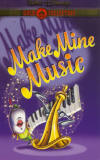 Make
Mine Music
(1946) Another package film, the Disney Studio marking time until
they could afford to produce another feature-length story. The two
previous ones, Saludos Amigos
and The Three Caballeros
had a theme: South America. Two films to come—Fun and Fancy
Free and The Adventures of Ichabod and Mr. Toad—were
just two stories slapped together to make feature length. This one
and Melody Time were pretty much tossed together at
random, using every idea that had been lying around for some time
and was not worthy of a full feature. This is not necessarily a bad
thing—though both films are often referred to as “poor man’s
Fantasias”—but it does mean these films are very uneven. And
I have no doubt that children, the target audience of these
videotapes, would fast forward through several of the segments.
Luckily, those segments are all short.
Make
Mine Music
(1946) Another package film, the Disney Studio marking time until
they could afford to produce another feature-length story. The two
previous ones, Saludos Amigos
and The Three Caballeros
had a theme: South America. Two films to come—Fun and Fancy
Free and The Adventures of Ichabod and Mr. Toad—were
just two stories slapped together to make feature length. This one
and Melody Time were pretty much tossed together at
random, using every idea that had been lying around for some time
and was not worthy of a full feature. This is not necessarily a bad
thing—though both films are often referred to as “poor man’s
Fantasias”—but it does mean these films are very uneven. And
I have no doubt that children, the target audience of these
videotapes, would fast forward through several of the segments.
Luckily, those segments are all short.
The film is presented as a concert, though it’s hard to imagine a venue where all these numbers would be performed on the same evening. There were originally 10 segments, but “The Martins and the Coys” fell victim to political correctness and was snipped from the home video release, because of “comic gunplay.” Damn, I can’t tell you how much I hate that. Warner Bros. suppressed their racist films (though they’re easy to find at YouTube) but never even considered pulling all their Yosemite Sam ‘toons just because he’s always shootin’ up the place. So here’s what’s left:
A Rustic Ballad: The Martins and the Coys (CENSORED)
No, wait! YouTube to the rescue! Here it is.
Tone Poem: Blue Bayou. The Ken Darby Chorus. Talk about poor man’s Fantasia … this one was lifted from the floor of the room where they were cutting Fantasia, dusted off, and inserted here. Well, not exactly, it was animated a few years later, but was originally meant to be shown to Claude Debussy's Clair de lune. There is no story, just a heron moving through a swamp accompanied by a rather insipid song. I wish they’d stuck with the Debussy.
Jazz Interlude: All the Cats Join In. This is my personal favorite, and strangely enough my second choice is also by Benny Goodman. But this one really shines. It uses the frequent Disney trope of the paintbrush, but this time it is a pencil, which sketches in the characters, then the props, then very sparse sets. There are no backgrounds. It’s about teenage hepcats rendezvousing at the local malt shoppe to jitterbug to the latest grooves, Jackson! They boogie so hard and so fast that the pencil sometimes can’t keep up. When their jalopy takes off with no rear wheels, the pencil has to race ahead and draw a stoplight. This segment is full of nice little touches like that, and the music is all reet, too.
Ballad in Blue: Without You. About the best you can say for this is that it’s pretty. It’s also boring. Andy Russell sings the song, and we see what looks like water moving over glass, and shifting colors. Much visual artistry is pretty much wasted here.
Musical Recitation: Casey at the Bat. Jerry Colonna narrates the famous poem, with antics more at home in a Goofy cartoon than a musical collection. It doesn’t really fit in, but I’m not complaining too much, because it’s funny.
Ballad: Two Silhouettes. Another one that’s a snooze, yet quite pretty. Two rotoscoped ballet dancers move against an abstract background as Dinah Shore croons the title melody. Nice voice, dull song.
Fairy Tale in Music: Peter and the Wolf. One of the Disney classics, which has been shown by itself in many contexts. It’s narrated nicely by Sterling Holloway. This being Disney, they couldn’t allow the duck to be eaten, and they give the animals names, which Prokofiev didn’t, but who cares? My only objection was that when they were introducing the characters and the instruments that represented them—oboe: duck; bassoon: Grandpa; flute: bird, etc.—they failed to mention that the Wolf (the real star of the show and one of the scariest images Disney ever produced), was represented by French horns. As an old French horn player, I was miffed.
This little orchestral trifle has to be one of the most performed and most parodied works in the classical canon. Thanks to Wikipedia, which excels in things like this, for this amusing list of people who have narrated it over the years:
Sergei Prokofiev's first wife Lina Prokofiev, son Oleg Prokofiev, and grandson Gabriel Prokofiev, José Ferrer (bilingual in English and Spanish), Sir Ralph Richardson, Sir John Gielgud, Leonard Bernstein, Basil Rathbone, Boris Karloff, Christopher Lee, Sean Connery, Peter Ustinov, Paul Hogan (relocated to the Australian Outback), Will Geer, Dudley Moore, Hermione Gingold, Captain Kangaroo, Mia Farrow, Itzhak Perlman, Lorne Greene, Sir Alec Guinness, Jonathan Winters, Patrick Stewart, Ben Kingsley, Dame Edna Everage, Tom Seaver, Carol Channing, George Raft, Sting, David Attenborough, William F. Buckley, Jr., and Arthur Godfrey.
Those were merely the classical readings. There have been endless variations, including:
Art Carney and the Bil Baird Marionettes; Hans Conried with a Dixieland band; the Clyde Valley Stompers, jazz version; Robin Lumley and Jack Lancaster, rock version, Arnie Zane, punk ballet version (!!); Weird Al Yankovic and Wendy Carlos, comedic version with synthesizers; P. D. Q. Bach, comedic western version entitled “Sneaky Pete and the Wolf.” Chuck Jones drew the characters for a TV version, and National Public Radio produced “Peter and the Wolf: A Special Report,” which treats it as if it were a developing news story.
Suzie Templeton and Hugh Welchman directed a modernized, stop-motion animated adaptation that won an Oscar in 2008.
And perhaps the most bizarre version of all: Bill Clinton, Mikhail Gorbachev, and Sophia Loren won a Grammy Award for Best Spoken Word Album for Children for narrating the album Peter and the Wolf/Wolf Tracks. Loren narrated “Peter and the Wolf” and Clinton narrated “The Wolf and Peter” by Jean-Pascal Beintus, which is the story told from the wolf’s point of view. I can’t figure out what Gorby did; maybe provide a Russian translation.
Goodman Quartet: After You’ve Gone. The second jazz piece. This one takes four musical instruments and morphs them through an insane number of changes, through a surreal landscape of piano keys and musical staffs and whatever the animators happened to see, inspired by whatever they were smoking that day. Whatever it was, I’d like a few tokes.
Love Story: Johnny Fedora and Alice Blue Bonnet. The Andrews Sisters sing of a romance between two hats. Disney made cartoons where two cars were lovers, and also two houses. (I kid you not.) This is even more farfetched, and didn’t really work for me, though the animation was quite clever.
Opera Pathetique: The Whale Who Wanted to Sing at the Met. A great story, and a real tour de force for Nelson Eddy, who sings all the parts. And there are dozens of parts, over a vocal range that is astonishing. (I suspect he may have had a little technical help in the upper registers.) It was a real eye-opener for me, who had previously seen Eddy only in some of those truly awful and dreadfully dated musicals from the late ‘30s and early ‘40s. Who could forget him dressed as a Canadian mountie in Rose-Marie, warbling one of the worst songs ever written, “Indian Love Call,” to Jeanette MacDonald? Or “Stout-hearted Men” from New Moon? I wish I could forget. But he really shines here, singing many of the most famous operatic arias for tenor, baritone, and bass. The story is good, too, so improbable that I found myself caught up in its appealing lunacy. I mean, wait until you see a sperm whale standing on stage in an opera house! I remember seeing this as a child, and being shocked and hurt that the whale was harpooned. Seeing him entering the Pearly Gates didn’t make up for it. I was pissed, I wanted to find that idiot impresario Tetti-Tatti and break his arms so he could never conduct again.
The videotape comes with two classic cartoons:
“The Band Concert” (1935), always on the Top Ten list of best cartoons ever. The level of detail when the bandstand is picked up by a tornado is amazing. To think that it was all hand-drawn, with literally hundreds of elements to consider in each cel … today a computer could handle it all easily, but back then it was hard. And well worth the effort. It stars Mickey, acting rather more angry than we’re used to seeing, and an early version of Donald Duck (only his third appearance in a cartoon), who discovers that “Turkey in the Straw” can be played right along with the William Tell Overture. And does so, to the confusion of the band.
“Farmyard Symphony” (1938) Walt always liked rural life, farm animals, etc. Just look at how many animals are in “Steamboat Willie.” Here, the animals are much more realistically drawn, and the schtick is that their braying and oinking and clucking make a sort of symphony. IMDb.com
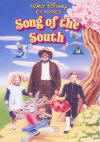 Song of the
South
(1946) There was
The Birth
of a Nation,
D.W. Griffith’s
repulsive masterpiece that portrays Negroes as sex-crazed simpletons and
the KKK as the
saviors of white womanhood. There was
The Triumph
of the Will,
Leni Riefenstahl’s
repulsive masterpiece that shows Hitler as a demigod and Nazism as an
innocent romp not unlike a Boy Scout camporee or a Fourth of July
parade. And then there was Song of the South.
Song of the
South
(1946) There was
The Birth
of a Nation,
D.W. Griffith’s
repulsive masterpiece that portrays Negroes as sex-crazed simpletons and
the KKK as the
saviors of white womanhood. There was
The Triumph
of the Will,
Leni Riefenstahl’s
repulsive masterpiece that shows Hitler as a demigod and Nazism as an
innocent romp not unlike a Boy Scout camporee or a Fourth of July
parade. And then there was Song of the South.
Walt knew he might have a problematic film on his hands even before animation began. He said to the director, “The Negro situation is a dangerous one. Between the Negro haters and the Negro lovers there are many chances to run afoul of situations that could run the gamut all the way from the nasty to the controversial.” I think he expected the worst reactions from the haters, the Kluxers and the like. Ironically, the biggest detractors of this sweet and corny little film over the years have been the NAACP and others like them. They objected to what they described as an idyllic master-slave relationship. Ahhhh … well, gee, folks, you can surely object to the apparently happy black cotton-pickers (though I don’t, and there is nothing here anywhere near as objectionable as Stepin Fetchit), but the film is not antebellum, it is set some years after the Civil War. Yes, those ex-slaves are certainly being exploited (as they would be, though less so, when they moved to Detroit for better jobs), but when Uncle Remus decides to take off for Atlanta, he’s got every right to do so. He’s a free man.
As for portrayals, I can’t see anything that bad here. The little black boy is barefoot and ragged, but has the same sense of fun as the white boy. He’s not nearly the caricature that Buckwheat and Stymie were. Uncle Remus speaks in dialect—and how else should he speak?—but he and the white grandmother, who get along very well and respect each other, are by far the wisest people to be seen. The black extras spend a lot of time singing mostly happy songs—though one number is quite bluesey—and what’s wrong with that? It’s a hard life. Wouldn’t you want to kick back and sing at the end of the day?
However, the Disney Company does not want its name to be associated with anything this controversial, so it has never released this movie on VHS or DVD … in this country, anyway. But I guess Europeans and Japanese are from another planet, because there has been a PAL version in the Europe, and an NTSC version in Japan.
(There are persistent rumors that an American DVD release is coming. I say, go for it. It doesn’t have to be a wide release, where every child in the nation wants a copy—though I see nothing wrong with that; watch it with your children and it’s a good chance to discuss racism, and how attitudes have changed. But if not that, do it like they did Victory Through Air Power recently, as part of the Disney Treasures series of boxed sets, aimed primarily at Disneyphiles like myself.)
But in the meantime, guess what, folks? I have a copy of the Japanese release! Yes!!! Portland’s best video rental place, Movie Madness, had a copy, and some years ago I took it home and duplicated it. I just recently dug it out of the musty, dusty Varley Vaults in Mom’s basement and took it home to view. And what a trip it is! I’d advise everybody to get the Japanese version if they can, if only for the weird (to an American) extras. There are two versions of the film on this tape. The first has Japanese subtitles … but only for the songs. I can’t figure that out. Why not subtitles all the way through? So while I’m watching and listening, I’m looking at those Japanese squiggles at the bottom and wondering what they’d sound like. How does zip-a-dee-doo-dah translate into Japanese? For a people who pronounce “baseball” as “besaboru,” anything is possible.
But the real lark is to watch a bit of the second version. It is dubbed, and quite well, too. It’s funny to see any of these characters speaking fluent Japanese, but the real howl is to see the late, great Hattie McDaniel speaking it. Later, when Br’ers Rabbit, Fox, and Bear speak Japanese, that’s funny, too.
So. Enough about that. How was the movie? Well, partly genius and partly a bit of a snooze. Disney wasn’t that good at live action at that time (and for some time to come, now that I think of it), but as always, the animation is brilliant. I could wish they’d come up with a better story frame for these animated sequences, other than the tired old plot they chose. There are only three Br’er Rabbit stories here, and there could have been eight or ten. There are the usual insufferable movie children of this era, with dialogue to make your ears cringe. The main offender, simply because he’s on-screen most of the non-animated time, is little Bobby Driscoll, who was the voice of Peter Pan and also starred in So Dear to My Heart (which some say was Walt’s favorite, and is really pretty bad). Somebody out there is a big fan of Bobby, because he or she wrote a long, exhaustive article about him for Wikipedia. Check it out. Most child stars’ stories from that era are bad, but his was especially tragic.
Mention should be made of James Baskett, who played Uncle Remus (and voiced Br’er Fox, something I didn’t know). He was one of the first Hollywood performers who had to learn to react to stuff that just wasn’t there, things that would be put in later by the animation department. In these days of blue-screen movies, where the entire film is shot without sets, it’s a skill any actor better have. He does very well with it, and in every other department. It’s not fair that some people view him as an “Uncle Tom,” that pejorative from the ‘60s for someone playing the white man’s game. He was a damn good actor, and sold the part of Uncle Remus with great skill. I love most of this film. IMDb.com
(1947) Two movies for the price of one! Of course, added together they’re only 73 minutes long, but that’s long enough for kids. (It’s a little sobering to realize that I’m not quite two months older than this film.) Both the stories here were in development as early as 1939 to 1941, but you know what happened then. After Tojo’s little surprise party in Hawaii the Disney studios were kept busy with wartime training and propaganda films. Post-War, they had a lot of ideas sitting around half-finished. Both of these were originally intended to be feature-length, but they work well, maybe even better, at the shorter length. On the video I have there is a 20-minute short showing a lot of very interesting information, including recently-discovered footage of Walt recording Mickey’s voice for Mickey and the Beanstalk, along with Billy Gilbert as the giant. I was glad to see Gilbert, because I soon realized he was the apoplectic Professor von Schwarzenhoffen in one of Laurel and Hardy’s best two-reelers: “The Music Box.”Bongo. About a circus bear who longs for the great outdoors and escapes on his unicycle. The great outdoors is more than he bargained for, but he triumphs in the end. The animation style is simple and boisterous, and the story is good. This story is introduced by Jiminy Cricket, who sings the title song.
Mickey and the Beanstalk. The Mouse is joined by Goofy and Donald in a re-telling of the old fairy tale. The magic Singing Harp has been stolen from Happy Valley, which has thus fallen on hard times, and starvation. There’s some very good stuff here, including Mickey slicing a piece of bread so thin you can see through it, and the amazing growth of the beanstalk, lifting the house and three heroes into the air. In the extra material I learned what happened in an obviously missing scene, when Mickey takes the cow to town to trade it for food, and comes back with a handful of beans. He is taken before the Queen, who turns out to be Minnie Mouse, and she buys the cow. We see the storyboards that were drawn up. Fascinating stuff. In the end, they realized the scene wasn’t needed—all we really needed to know was that Mickey apparently got scammed—so in the interest of shortening the story the scene was never animated. This segment is hosted by Edgar Bergen, the radio ventriloquist, who seems to be throwing a very small party for Luana Patten, aided by Charlie McCarthy and Mortimer Snerd. For once the dummies move and speak without sitting on Bergen’s lap, but his lips still move. IMDb.com
(1948) The penultimate of Disney’s package films, with only The Adventures of Ichabod and Mr. Toad to go. Where Saludos Amigos and The Three Caballeros are travelogues, I’ve found it useful to think of this one and Make Mine Music as short story collections which, I hope, gives them a little more dignity artistically and explains the lack of thematic coherence. As any writer can tell you, it’s almost impossible to make a living writing short stories, and these days only Pixar of the large studios regularly makes the cinematic equivalent, the short cartoon. (The good news is that there are scads of the faithful keeping the form alive in basement and garage studios, and on their computers, but I doubt many are making a good living at it.) I’m conflicted on how to describe F&FF and Ichabod, which each have only two stories. I guess you could call them mini-double features. I prefer to compare them to those fondly remembered Ace Double SF Novels of the 1950s and ‘60s, where you had to turn them upside-down to read the other novel. Those stories were usually novellas in terms of actual word count. (Ohmigod, I just encountered a quote concerning those Ace Doubles that I have to put in here: “If the Holy Bible was printed as an Ace Double it would be cut down to two 20,000-word halves with the Old Testament retitled as ‘Master of Chaos’ and the New Testament as ‘The Thing With Three Souls.’” – Charles McGrath.)I think Melody Time is quite a bit better than its predecessor. Even the least interesting one is fabulous to look at.
Once Upon a Wintertime. Frances Langford sings as a boy and a girl go sleigh riding and ice skating, and get into trouble. At the same time, a pair of bunny rabbit lovers pretty much ape every move. It’s quite funny, and the animation style is simple and strong.
Bumble Boogie. Freddy Martin and his orchestra (with Jack Fina on the piano) play a jazz variation of Rimsky-Korsakov's “Flight of the Bumblebee,” in the surrealistic nightmare style of “After You’ve Gone” from Make Mine Music. This one is even better. It seems this one was considered for Fantasia (I’m guessing it would have been the original orchestral version) but didn’t make the cut.
The Legend of Johnny Appleseed. A sweet little fable telling the (somewhat) true story of John Chapman, who really did travel the West (what we now call the Midwest) planting apple trees. Usually nobody mentions that he intended to make a profit on all those orchards, and he did. He was an early member of that odd cult, vegetarians, and led quite an ascetic life. Dennis Day voices him, as well as the two other speaking parts. I recall Dennis Day from the old “Jack Benny Show” as what we these days call an airhead. I liked him.
Little Toot. Based on the poem by Hardie Gramatky, and sung by the Andrews Sisters. Not my favorite, but full of action and humor.
Trees. The Alfred Joyce Kilmer poem set to music by Fred Waring and the Pennsylvanians. The poem really sucks, in my opinion, and the singing here is way too reverent. But it is stunning to look at, and the transitions are very inventive, with one thing turning smoothly into another. I remember “Trees” from an old routine by Shelley Berman, where he says he thought James Joyce wrote it. The condescending person he is talking to chuckles, and says, “James Joyce didn’t write ‘Trees.’ ‘Trees’ was written by Joyce Kilmer.” To which Shelly replies “Who’s she?” and got a big laugh. I didn’t get it. Well, I sure as hell didn’t know any men in Texas named Joyce, possibly because the first time they said their name they would be promptly shot.
Blame It On the Samba. Donald Duck and José Carioca with the Aracuan Bird. Vocals by the Dinning Sisters, and Ethel Smith plays the Hammond organ., fabulously, even when it explodes and then reassembles itself around her in mid-air. This seems to be left over from the South American trip, and it is as dazzling as the best material there.
Pecos Bill. Roy Rogers and the Sons of the Pioneers tell and sing the story of the Texas legend to the ubiquitous Bobby Driscoll and Luana Patten. It’s sharp and funny, and pisses me off. I’ve ranted elsewhere about the chickenshit decision of the Disney wonks (no doubt the same chickenshits who won’t release Song of the South on video) to remove all traces of the cigarette that used to be constantly dangling from Bill’s lip. Once again they surrender to political correctness and re-write history, not unlike the Soviets used to PhotoShop (before there even was a PhotoShop) pictures to remove people who had been liquidated or sent to the gulag. But the funny thing is—once again like Song of the South—they did that only to the NTSC version. NTSC is the television standard of North America, Japan, the Philippines, Burma (Burma?), and all of South America except the two countries that matter most, Brazil and Argentina. Pretty much all of the rest of the world except Russia, France, and some African countries (who use something called SECAM) use the PAL system. This is the big majority of humanity, including India and China. For some reason, Disney deems these PAL people adult enough to watch people smoke (and, one hopes, tell their children that it’s a bad thing to do, but it was a different era), and to see Song of the South without immediately wanting to rush out to Wal-Mart and buy a few slaves. Why don’t they trust us to be as grown-up? IMDb.com
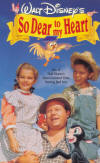 So
Dear to My Heart
(1949) I watched this one when I first got the tape, and probably would
have skipped it now except that I wanted to view all the Disney animated
features in order. (I put this and other partially animated films on my
list; some don’t.) It’s not really worth a second look … in fact, it’s
probably not even worth a first look for most people, except the very
young. I read somewhere it was one of Mr. Disney’s favorites of the
films he made, because it was set in the rural Midwest in 1903, where he
lived from age 4 (1905) to age 8. He always fondly remembered farms and
small-town life, and that’s what this is about: A boy (Bobby
Driscoll) raising his pet lamb to take it to the county fair. It’s a
collection of incidents, most of them involving the pain-in-the-ass
ovine ruminant wreaking havoc to an extent that he would have been lamb
chops on the plate that very evening if it had been my farm. I just
don’t have much empathy for livestock. Stupid animals.
Beulah Bondi
(who I remember fondly as Jimmy Stewart’s mother in
It’s a Wonderful Life)
plays the stern but soft-hearted granny,
Burl Ives is the
sympathetic uncle. I’m sorry to say he sings a lot, including that awful
“Lavender
Blue (diddley diddley).” No clue is given as to what
happened to Ma and Pa. The three short animated pieces are up to
Disney’s usual standards, very imaginative, and involve a wise old owl
who comes to life in a turn-of-the-century Victorian scrapbook. Sorry,
Walt, this is just not a very good film.
IMDb.com
So
Dear to My Heart
(1949) I watched this one when I first got the tape, and probably would
have skipped it now except that I wanted to view all the Disney animated
features in order. (I put this and other partially animated films on my
list; some don’t.) It’s not really worth a second look … in fact, it’s
probably not even worth a first look for most people, except the very
young. I read somewhere it was one of Mr. Disney’s favorites of the
films he made, because it was set in the rural Midwest in 1903, where he
lived from age 4 (1905) to age 8. He always fondly remembered farms and
small-town life, and that’s what this is about: A boy (Bobby
Driscoll) raising his pet lamb to take it to the county fair. It’s a
collection of incidents, most of them involving the pain-in-the-ass
ovine ruminant wreaking havoc to an extent that he would have been lamb
chops on the plate that very evening if it had been my farm. I just
don’t have much empathy for livestock. Stupid animals.
Beulah Bondi
(who I remember fondly as Jimmy Stewart’s mother in
It’s a Wonderful Life)
plays the stern but soft-hearted granny,
Burl Ives is the
sympathetic uncle. I’m sorry to say he sings a lot, including that awful
“Lavender
Blue (diddley diddley).” No clue is given as to what
happened to Ma and Pa. The three short animated pieces are up to
Disney’s usual standards, very imaginative, and involve a wise old owl
who comes to life in a turn-of-the-century Victorian scrapbook. Sorry,
Walt, this is just not a very good film.
IMDb.com
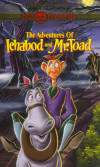 The
Adventures of Ichabod and Mr. Toad
(1949) And so we come to the last of the six package films. Next up:
Cinderella!
The
Adventures of Ichabod and Mr. Toad
(1949) And so we come to the last of the six package films. Next up:
Cinderella!
I like all these films, and this is no exception. It begins with Mr. Toad, taken from Kenneth Grahame’s The Wind in the Willows. It is narrated by Basil Rathbone. It was the second movie Disney made from one of Grahame’s books, the first being The Reluctant Dragon. Again, I never read it, but my hat is off to him for making a sympathetic character out of a damn rat. I mean, a mouse is one thing, but a rat? The story has been considerably simplified, from what I just read about it. It could easily have been a feature, but I’m sort of glad it wasn’t. It’s a good story, and the climactic battle with the weasels in Toad Hall is lots of fun, but it’s not my favorite. I don’t want to make a children’s story bear too much metaphorical weight, but Toad is actually pretty awful, and the story is drenched in British class consciousness. He is destructive and fairly stupid, but rich, and thus indulged. He could be a contestant in the Upper Class Twit-of-the-Year competition. The main thing he has contributed to the Disney experience is Mr. Toad’s Wild Ride, one of the original Disneyland attractions in Fantasyland, and one of the small number still operating. Those cars have been barreling across the English countryside for 55 years now!
The Legend of Sleepy Hollow is, of course, based on the Washington Irving story, and seems to be pretty faithful to the material from what I remember of it. Ichabod is an engaging character. It would seem he doesn’t have much going for him, being an 18th century nerd, awkwardly built and bookish, but he’s full of surprises. He eats like a horse, and he’s a good dancer. He is winning the hand of the bodacious Katrina Van Tassel over the big, manly Brom Bones, but his superstition is his undoing. The chase of Ichabod and the Headless Horseman is a real riot, just filled with gags, with images scary enough that I wouldn’t be surprised if young children had bad dreams from it. IMDb.com
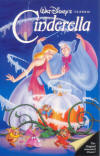 Cinderella
(1950) This was the first single-story feature made by the Disney
studios after the long hiatus caused by the war and financial
straits from the failure of some big films Walt was counting on to
keep him in business. If this one had flopped, Disneyland probably
would never have happened, as the studio would have gone belly-up.
But it was a big success, and Walt started thinking
about television and an amusement park. The rest is history.
Cinderella
(1950) This was the first single-story feature made by the Disney
studios after the long hiatus caused by the war and financial
straits from the failure of some big films Walt was counting on to
keep him in business. If this one had flopped, Disneyland probably
would never have happened, as the studio would have gone belly-up.
But it was a big success, and Walt started thinking
about television and an amusement park. The rest is history.
It’s a great one. I probably saw it during its 1957 initial re-release. It went on to be released again to theaters half a dozen times before video arrived. I don’t recall, but at 10 I was probably still receptive to a film aimed primarily at girls. The animation doesn’t have the rich detail of Snow White and the Seven Dwarfs or Pinocchio, but the artists manage to make that into an asset instead of a liability. It looks great. The acrobatics and pratfalls are provided by the two mice, Gus and Jaq, along with the evil cat, Lucifer (voiced by the great June Foray, the voice of Rocky the Flying Squirrel). I remember having a record of the song the mice and birds sing as they “make a lovely dress for Cinderelly.” The stepmother is as evil as any Disney evil woman (there certainly were a lot of them, weren’t there?), she just doesn’t make a big production of it. Cinderella is a good character, though I kept wishing she’d stand up for herself a little more. Medieval times; I guess a woman didn’t have many choices unless she found and married her Prince Charming, royal or not.
Ilene Woods was a lot easier on the ears than soprano Adriana Caselotti’s Snow White. Musical tastes had changed a lot in 13 years, for the better, in my opinion. There were two hit songs: “A Dream is a Wish Your Heart Makes,” and “Bibbidi-Bobbidi-Boo.” Perry Como covered the latter song. It was a more innocent age, wasn’t it?
This seems like a good time to bring up the Disney Princesses, which has turned out to be a gold mine for Disney, as if they needed another. Go to Disneyland any day and you will see hundreds of little girls dressed up as their favorite princess … and wearing clothes they bought at the huge Disney store just outside the gate. Girls can get practically anything with a princess tie-in on it, from pencils to cell phones. Cinderella was the second princess. There are now nine of them officially: Snow White, Aurora from Sleeping Beauty, Ariel from The Little Mermaid, Belle from Beauty and the Beast, Jasmine from Aladdin, Pocahontas, Mulan, and now Tiana from The Princess and the Frog. There will be ten when Rapunzel is released in November, 2010. I wondered why Alice and Wendy and Lilo weren’t included, then realized that the nine were all adults, and those three are still children. I think they might want to reconsider Lilo, though. They now have Native Americans, Asians, African-Americans, French people, Arabs and fish represented. Lilo would capture one more ethnic group: Pacific Islanders. They are now desperately in need of an Hispanic princess, but no such project has been announced. Get with it, Disney! There are a million brown girls out there looking for a Spanish-speaking princess in Los Angeles alone!
I’d like to make a suggestion while we’re on the subject of princesses. Disney people, you are welcome to use it for a small piece of the profits, say, fifteen percent? Everybody knows and loves the Disney princesses, but how about those villainesses? Lots of little kids have been rocked by the sheer awfulness of these women. Even myself! One of my most vivid memories of visiting the Disney resort was encountering Cruella De Vil on the street on the Hollywood Pictures Backlot at California Adventure. I posed for a picture with her, me all lit up with adoration, her with lip curled in her trademark sneer. I told her she was my favorite Disney animated character, and she said she was her favorite Disney animated character, too. Then she told me to beat it! My heart went pitter-pat. I’d been insulted by the magnificent Cruella!
There must be some girls out there who would enjoy dressing up as a Disney Villainess. I mean, the costumes are great, and that’s what it’s all about, isn’t it? I’m thinking of those future Goth girls, the ones who even now are considering what parts to pierce, where to put the tattoos, girls who are experimenting with black lipstick and nail polish and dead white facial makeup and torn black clothing. Don’t you think they’d relish dressing up as the malignant Cruella and ganging up on all those princesses in pretty pink gowns?
I’ve identified no less than 6 Disney Villainesses. That’s two-thirds of the current number of princesses. They are: The Queen from Snow White and the Seven Dwarfs; Lady Tremaine from Cinderella; the Queen of Hearts from Alice in Wonderland; Maleficent from Sleeping Beauty (another personal favorite of mine); Cruella De Vil from 101 Dalmatians; and Ursula the Sea Witch from The Little Mermaid. I considered Madame Medusa from The Rescuers, but I don’t remember much about her. I’ll wait until we view the movie to decide if she’s bad enough. I think we—the Disney management and myself—could make a tidy sum selling those costumes. Don’t you?
Oh, and be sure to hang on to your VHS or DVD, if you have one and care for historical authenticity. The King smokes a cigar here, and the next time they release a DVD of it they will probably have digitally removed it. IMDb.com
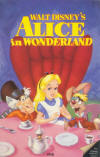 Alice
in Wonderland
(1951) Not a
huge hit at the time of its release, and I can see why. This movie
does a lot of things, but it doesn’t engage your heart. It’s much
like the book, which was mostly
Lewis Carroll
showing off, verbally and mathematically. (“Why is a raven like a
writing desk?” Because Poe wrote on both.) There is never a sense of
anything being at stake, and very little sense of Alice as a real
character. We never feel she is in any true peril, and though she
cries twice (once in tsunami quantities) I never felt she was
actually too worried about anything. She is in a dreamlike state of
just moving along from one scene to the next, illogically, and of
course it turns out it is a dream. The most emotion
Alice really displays is being a bit cross with one character or
another.
Alice
in Wonderland
(1951) Not a
huge hit at the time of its release, and I can see why. This movie
does a lot of things, but it doesn’t engage your heart. It’s much
like the book, which was mostly
Lewis Carroll
showing off, verbally and mathematically. (“Why is a raven like a
writing desk?” Because Poe wrote on both.) There is never a sense of
anything being at stake, and very little sense of Alice as a real
character. We never feel she is in any true peril, and though she
cries twice (once in tsunami quantities) I never felt she was
actually too worried about anything. She is in a dreamlike state of
just moving along from one scene to the next, illogically, and of
course it turns out it is a dream. The most emotion
Alice really displays is being a bit cross with one character or
another.
Having said that … what a trip! The flora and fauna of Wonderland, as imagined by the Disney artists, are all incredible. Things from other Carroll works are brought in, like “The Walrus and the Carpenter” and “Jabberwocky.” We just go from one wonder to another, climaxing in the croquet game with the Queen of Hearts, a great Disney Villainess.
This seems to me to be another Disney film that was ahead of its time. It wasn’t reviewed well. The Brits, in particular, loathed it because it Americanized an English classic. (As I write this we are weeks away from a new, live-action version by Tim Burton.) It wasn’t re-released until 1974, to cash in on the psychedelic rediscovery of some of the old Disney classics. But Alice has always been popular in other ways at the theme parks. She appears in many of the parades, and this is one of only two films that generated two Disneyland attractions: The Alice in Wonderland dark ride, and the Mad Tea Party teacups, one of the few rides that is in all five Disney parks. (The other film: Dumbo, with the Flying Elephant ride and the Casey Jr. Circus Train.)
This movie anticipated a trend that I have bemoaned elsewhere, of having well-known names voicing some of the characters. Jerry Colonna, Ed Wynn, and Sterling Holloway all worked in regular movies and had distinctive voices. (Holloway had worked in two previous Disney animated features.) But after this film, Disney largely went back to using voice actors. It wasn’t until many years later that Big Name Stars began voicing cartoons, usually to no good purpose other than having their names on the posters to draw in audiences who wouldn’t go see a picture without stars in it. And thus did a lot of good voice actors lose a lot of work. Sometimes, in my opinion, having Big Name Stars actually detracts from an animated film. Some actors just have no business going into the recording studio and trying to create a character solely from the voice.
PC Warning: The Walrus, the Dodo, and the Caterpillar all smoke. Boy, does that Caterpillar smoke, from a Turkish hookah, no less. There’s no telling what’s in that pipe, but judging from the psychedelic smoke he blows, it ain’t Prince Albert. It would be easy to do a Pecos Bill on the Walrus and the Dodo (digitally removing tobacco products so young minds won’t be warped—and good luck with that, in this Internet porn age), but the only way to deal with the Caterpillar would be to remove him entirely … which I wouldn’t put beyond the guardians of correctness. IMDb.com
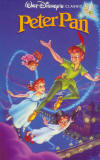 Peter
Pan
(1953) I
recall this movie with the most affection of any Disney animated
feature. I would have been six when it came out. I don’t know if my
family went to see it then (my sisters would have been three and
two) but if we didn’t, we surely saw it in its first re-release, in
1958. Age eleven would have been the perfect time to see it, as
ageless Peter looks to be somewhere in that age range. And I was
captivated. What boy wouldn’t have been? Not the part about not
wanting to grow up—I think most kids that age can’t wait
to grow up. (Little do they suspect.) And it wasn’t even the
adventures, though that wasn’t too shabby. No, it was the flying.
When they go out that window and soar over London, over the clouds,
swooping like birds and accelerating like jet planes … those scenes
lingered in my fantasies for years. Hell, they’re there even now.
Peter
Pan
(1953) I
recall this movie with the most affection of any Disney animated
feature. I would have been six when it came out. I don’t know if my
family went to see it then (my sisters would have been three and
two) but if we didn’t, we surely saw it in its first re-release, in
1958. Age eleven would have been the perfect time to see it, as
ageless Peter looks to be somewhere in that age range. And I was
captivated. What boy wouldn’t have been? Not the part about not
wanting to grow up—I think most kids that age can’t wait
to grow up. (Little do they suspect.) And it wasn’t even the
adventures, though that wasn’t too shabby. No, it was the flying.
When they go out that window and soar over London, over the clouds,
swooping like birds and accelerating like jet planes … those scenes
lingered in my fantasies for years. Hell, they’re there even now.
Walt had wanted to make this since 1935, but he couldn’t get the rights from the Great Ormond Street Hospital for Sick Children, to whom Barrie had willed them, until 1939, and then came the war. So he had plenty of time to think about it. One can make the usual complaints about faithfulness to the source material, and I’ll yawn my usual yawn. I’ve never seen either of the stage plays nor have I read the book, so why should I care?
The movie has survived intact, unlike Song of the South, in spite of some pretty insulting portrayals of Native-Americans, who we then called Indians. (Actually, they seem to want to be called Indians again these days. Fine with me.) The song “What Makes the Red Man Red?” is funny, if you listen to it, and also full of “wild Injun” conventions of the time, like saying Ugh! and How! Only older folks like me will recall just how big cowboys and Indians were in the early part of last century, up until the ‘60s. Cowboy shows filled the theaters, most of them B-movies, and dominated the TV sets all through the ‘50s. Frontierland was a major part of Disneyland when it opened, and they had actual Indians doing traditional dances. I wonder if they said ugh and how when talking to visitors? Very little of the original Frontierland is left, replaced by stuff like Big Thunder Mountain Railroad, and it’s unmourned by me. No kid plays cowboys and Indians these days. In Neverland, of course, there is no scalping and such unpleasantness. It’s all a game.
Not so with the evil Captain Hook, that codfish! He and his crew really are dastardly, and would make you walk the plank except that Pan would never allow it. My favorite parts of the movie involve Hook (brilliantly voiced—along with Mr. Darling—by the great Hans Conried), especially his epic battles with the crocodile, which are hilarious slapstick. The crocodile is a great character, with his metronomic eyes and his determination to finish the meal he started with that tasty hand.
In fact, everybody in Neverland is a lot of fun, and the Darling children suffer a bit in comparison. Michael is just a kid. John is a gentleman-in-training, and will grow up to be a stiff-upper-lip officer, and probably die uncomplainingly at Ypres or the Marne. Wendy … well, she wears out her welcome pretty fast. I know she feels responsibility for the boys, but hell, the Darling family has a super-intelligent dog, Nana, for that. They should have brought Nana along, and in fact they did in one version. Why can’t Wendy loosen up and have a little fun? All she really wants to do in Neverland is visit Mermaid Lagoon—which makes no sense at all; why would a girl want to see mermaids? I guess she has a bit of a schoolgirl crush on Pan, but she hardly shows it. That British reserve, I guess. And besides, she’s not very nice. Pan already has a girlfriend.
And even at age eleven I knew that for my romantic interest, I preferred Tinkerbell to hell and gone over proper Wendy. Tink was my kind of girl, the kind who speaks up for herself (well, rings up for herself) and takes no shit from anybody… albeit a bit small, I’ll admit. But maybe she had some pixie dust that would make her larger or me smaller …
This movie is the basis of the best ride in Fantasyland. I remember on my first visit to Disneyland—this would have been 1978, ’79, in there—I liked it better than Space Mountain, better than the Matterhorn, better than the Jungle Cruise. When that little pirate ship swooped out the window and soared over London Bridge, Big Ben, and on to Neverland … well. I was eleven again. The line is always long and the ride is only two minutes, but it’s worth it.
PC Warning: Hook smokes two cigars at once. The Indian Chief smokes a peace pipe and passes it on to Peter (maybe he doesn’t inhale), and then to John, who does inhale, and turns green. They can digitally remove stuff like that now. No telling if they might censor future DVD releases. IMDb.com
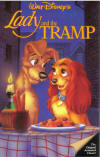 Lady
and the Tramp
(1955) I was eight, so I’m sure I saw this one when it was new. It
is interesting to see the dogs today. We are well into the movie
before Jock and Trusty the bloodhound speak. Before that, we see
only Lady, and she behaves exactly like a puppy behaves. In fact,
all the dogs exhibit purely doggy behavior, if we ignore little
things like their ability to read signs saying NO DOGS ALLOWED. A
very intelligent dog could do most of the things Tramp does. It is
easy to accept that the canines are simply speaking to each other in
dog language. There is nothing cartoonish about them. It is clear
that the animators studied dogs extensively.
Lady
and the Tramp
(1955) I was eight, so I’m sure I saw this one when it was new. It
is interesting to see the dogs today. We are well into the movie
before Jock and Trusty the bloodhound speak. Before that, we see
only Lady, and she behaves exactly like a puppy behaves. In fact,
all the dogs exhibit purely doggy behavior, if we ignore little
things like their ability to read signs saying NO DOGS ALLOWED. A
very intelligent dog could do most of the things Tramp does. It is
easy to accept that the canines are simply speaking to each other in
dog language. There is nothing cartoonish about them. It is clear
that the animators studied dogs extensively.
They left out a few behaviors, naturally. I kept thinking how cool it would be if they did what all dogs do the moment they meet one another: Go around and sniff the other’s ass. Or how about drinking water out of the toilet bowl, licking their crotches, or eating catshit out of the cat box? Okay, there goes the G-rating. And since this is a romance, you can’t acknowledge the fact that dogs are pack animals, not pair-bonding animals, and as soon as Tramp knocked up his little Lady, he’d never see her again, much less care for her little scamps. There’s a scene where Jock and Trusty come a’callin’, purpose: Matrimony. I didn’t see why, until Lee pointed out that those pups at the end of the movie arrived pretty damn soon after the big chase. Trusty was still walking with a splint on his leg from the injury sustained when the dogcatcher’s wagon fell on him. It seems certain that the Lady lay down with the Tramp right after that fine Italian dinner. They were trying to let her avoid the shame of being—gasp!—an unwed mother. Let’s not even get into the issue of female dogs in heat and what it does to all the male dogs in the neighborhood, which might explain the real reason Jock and Trusty were there …
I remember an episode of “Disneyland” where Peggy Lee showed how she was able to sing both parts of those nasty, horrible Siamese cats, Si and Am. It was the first time I was aware of some of the technical aspects of making a film like that. Peggy also did the voice for one of the more appealing minor characters, Peg (a Lhasa Apso?), who sings a song that was to be covered by many female singers later, “He’s a Tramp.” I wonder if the writers realized that the most likely reason for a female to be in jail is prostitution? It seems obvious to me, seeing it now, that she was a hooker with a heart of gold. I suspect those guys got a lot of laughs over that one. I do recall being very sad seeing those dogs howling in sorrow at the pound. Pounds are such sad places.
This is one of the few times one of my favorite satirists, Stan Freberg, did a voice for Disney. He was Mr. Busy the Beaver, who spoke with a whistle. IMDb.com
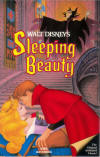 Sleeping
Beauty
(1959) When I think of the finest of the Disney classics, this one
has seldom come to mind, but looking at it again, I think it ranks
right up there with the greats. It is radically different in visual
style from anything Disney had done before, but only if you consider
just the feature-length movies. All through the ‘50s there was
innovation in animation from many smaller studios, and Disney
dabbled in these new, less complicated but visually wonderful styles
in shorts like “Toot,
Whistle, Plunk and Boom” (1953), “Pigs
is Pigs” (1954), “A
Cowboy Needs a Horse” (1956), “Paul
Bunyan” (1958), and “Noah’s
Ark” (1959, the only stop-motion Disney short I’m aware of).
Sleeping Beauty is meant to evoke medieval art without
actually imitating it. Some of the backgrounds seem almost
impressionistic, particularly the forests. There is more standard
Disney fare, too, such as the characters of the fairies Flora,
Fauna, and Merryweather and King Stefan and King Hubert. The two
kings don’t seem to fit well with the rest of the art, and they slow
the action down, which is my only criticism of the film.
Sleeping
Beauty
(1959) When I think of the finest of the Disney classics, this one
has seldom come to mind, but looking at it again, I think it ranks
right up there with the greats. It is radically different in visual
style from anything Disney had done before, but only if you consider
just the feature-length movies. All through the ‘50s there was
innovation in animation from many smaller studios, and Disney
dabbled in these new, less complicated but visually wonderful styles
in shorts like “Toot,
Whistle, Plunk and Boom” (1953), “Pigs
is Pigs” (1954), “A
Cowboy Needs a Horse” (1956), “Paul
Bunyan” (1958), and “Noah’s
Ark” (1959, the only stop-motion Disney short I’m aware of).
Sleeping Beauty is meant to evoke medieval art without
actually imitating it. Some of the backgrounds seem almost
impressionistic, particularly the forests. There is more standard
Disney fare, too, such as the characters of the fairies Flora,
Fauna, and Merryweather and King Stefan and King Hubert. The two
kings don’t seem to fit well with the rest of the art, and they slow
the action down, which is my only criticism of the film.
The movie was eight years in production. There is so much to like here. I wasn’t aware until many years later that most of the score is adapted from Tchaikovsky’s ballet, “Sleeping Beauty.” It was a brilliant choice, and gives the movie a darker, more serious tone. The waltz “Once Upon a Dream” is one of my favorite Disney numbers. The look of the character Briar Rose/Princess Aurora was modeled on Audrey Hepburn!
I think the final scenes with Prince Philip escaping from the Forbidden Mountain and fighting his way back to the castle where Aurora and everyone else is sleeping is one of the finest action sequences ever animated. And the climax, where Maleficent transforms herself into a dragon … well, it scared the hell out of me when I was twelve. They have duplicated the scene in the outdoor summer show at Disneyland called Fantasmic!, and it’s one of the highlights. And speaking of Maleficent … my heart still belongs to Cruella De Vil, but oh, you Mistress of All Evil! How cool is it to call yourself that? She is without a doubt the scariest of the Disney scary evil women. She looks terrific, I just love her hat, or are those really horns? In addition to being a dragon, she can turn herself into a glowing green ball of light that just looks like it could suck the life right out of you. She was voiced by Eleanor Audley, who also did another creepy villianess for Disney, Lady Tremaine in Cinderella. And her face really did look something like both those bad girls. She did a lot of television, including Eddie Albert’s mother in “Green Acres.” IMDb.com
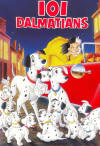 One
Hundred and One Dalmatians
(1961)
One
Hundred and One Dalmatians
(1961)
Cruella De Vil, Cruella De Vil
If she doesn’t scare you, no evil thing will
To see her is to take a sudden chill
Cruella, Cruella De Vil.
Oh, Cruella, my divine Cruella! My heart belongs to you, and always has. Maleficent tried to seduce me away from your cruel embrace, and I admit I was tempted, but I always came back to you. Briar Rose? Cinderella? Snow White? Their charms are as nothing compared to your sleek, magnificent presence! Those cheekbones, that hair, the way you brandish that cigarette holder and fill the air with your toxic green smoke … I still treasure that magic moment at the Disney Resort when we met, and you spoke to me. “Beat it!” you said, and I did beat it… and so did my heart. (I’m sure that you would tear my heart from my chest and eat it with some fava beans and a nice Chianti …)
Okay, this is a respectable entry in the Disney canon. This is where the animators began to use the xerography process, which made things look a little less rich, a little less well-defined. Walt didn’t like it, but it saved a lot of money. For the most part, the artists were able to work with it and, by wise choices, use it to their advantage rather than as a drawback. It meant switching to a more modern style that persisted until the advent of CGI opened new frontiers for everybody.
It’s based on a novel, and as with all based-on-novels Disney films so far, I haven’t read it. (In fact, other than a few stories from The Jungle Book, I never read any of the source material for a Disney film until he made The Many Adventures of Winnie-the-Pooh, which didn’t impress me, so it’s probably a good thing that I didn’t read many children’s books when I was growing up, switching early to Heinlein juveniles and adult science fiction.) As usual, Disney took the parts he wanted and changed things here and there to suit him. It doesn’t sound like any of these changes violated the spirit of the book. One dog character was eliminated, and the main male human character—Pongo’s “pet”—was changed from a mathematician/economist to a songwriter. Stuff like that. There are several things for Disneyphiles to notice. In a pet shop window during the Twilight Bark we can see Peg and the bulldog from Lady and the Tramp. All the puppies like to watch television, and one show they watch is a 1929 Disney cartoon, “Springtime.” Another show is “What’s My Crime?” a clever spoof of “What’s My Line?” with John Charles Daly, a show I got to see in New York when I went there for the 1964-65 World’s Fair.
Weird Trivia: Somebody seriously in need of getting a life claims to have counted all the spots on all the Dalmatians, frame by frame. In case anybody ever asks you, the number was 6,469,952. It’s sure to come up in conversation now and then.
PC Smoking Warning: Roger puffs on his pipe a lot, and Cruella is always smoking a cigarette and blowing green smoke. IMDb.com
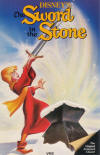 The
Sword in the Stone
(1963) Once again, I have to admit that I am not that familiar with
the source material, which is the first part of
T.H. White’s
tetralogy
The
Once and Future King. And I’d have to say that this one
has some of the same problems as
Alice in Wonderland,
mainly that it is great execution and not enough heart. I never felt
deeply involved in the plot, and didn’t have as much empathy for
young Wart (AKA Arthur) as I should have. Someone pointed out in an
article on Disney’s Sleeping Beauty
that it was really the story of the three fairies, since their
doings take up the most screen time. (Briar Rose/Princess Aurora
only appears for 18 minutes.) In a different way, this seems to me
to be the story of
Merlin, who is much the more interesting character. Wart is
unformed—the whole point of the story being Merlin’s education of
him. Then, abruptly, he stumbles on the sword, and is hailed as the
King. He’s done nothing to deserve it, and that pisses me off a
little. When Wart pulls the sword from the anvil and stone, a light
shines down, presumably from Heaven, which looks like an endorsement
of the Divine Right of Kings. Of course, that was the prevailing
sentiment at the time, but I don’t have to like it. As I said, he’s
done nothing, and his education is woefully incomplete. He doesn’t
even know how to read yet. If God was picking, his criteria were as
inscrutable as usual.
The
Sword in the Stone
(1963) Once again, I have to admit that I am not that familiar with
the source material, which is the first part of
T.H. White’s
tetralogy
The
Once and Future King. And I’d have to say that this one
has some of the same problems as
Alice in Wonderland,
mainly that it is great execution and not enough heart. I never felt
deeply involved in the plot, and didn’t have as much empathy for
young Wart (AKA Arthur) as I should have. Someone pointed out in an
article on Disney’s Sleeping Beauty
that it was really the story of the three fairies, since their
doings take up the most screen time. (Briar Rose/Princess Aurora
only appears for 18 minutes.) In a different way, this seems to me
to be the story of
Merlin, who is much the more interesting character. Wart is
unformed—the whole point of the story being Merlin’s education of
him. Then, abruptly, he stumbles on the sword, and is hailed as the
King. He’s done nothing to deserve it, and that pisses me off a
little. When Wart pulls the sword from the anvil and stone, a light
shines down, presumably from Heaven, which looks like an endorsement
of the Divine Right of Kings. Of course, that was the prevailing
sentiment at the time, but I don’t have to like it. As I said, he’s
done nothing, and his education is woefully incomplete. He doesn’t
even know how to read yet. If God was picking, his criteria were as
inscrutable as usual.
Merlin, on the other hand, is fascinating. He has traveled in time and knows about all sorts of future inventions. But he’s a little absent-minded, and can’t keep it all straight. His battle with the mad Madam Mim is the high point of the movie, richly inventive and a lot of fun to watch as each transforms into different animals in an attempt to gain an advantage.
PC Smoking Warning: Merlin smokes a lot, and sees visions in the clouds of smoke, so once again we can’t be sure what he’s smoking, but I wouldn’t count on it being tobacco. IMDb.com
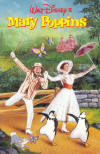 Mary
Poppins
(1964) I am on record many times in these reviews as
being okay with the “Disneyfication” of classic children’s books and
fairy tales. I haven’t changed my mind here, though this one was
probably the most hotly condemned of any, possibly because the
author, P.L.
Travers, was still alive, and hated, hated, hated
the movie. And indeed it sounds like Walt pulled a fast one on her.
She demanded script approval when she sold the rights, and she got
it, but she hadn’t realized that very few movies are filmed exactly
according to the script you had when you began. Walt had final cut,
and he put things in that weren’t in the original script, and
refused to take out stuff that Travers didn’t like. And perhaps I’m
prejudiced in favor of Walt. Though I usually would side with the
author, I think she was dead wrong in most of her objections. She
didn’t want an animated sequence, for instance, and I think the trip
into the sidewalk chalk art was one of the highlights of the
picture. She wasn’t really happy with there being music in it, and I
think she was wrong there, too. And she didn’t like it that Mary was
made to be not nearly so harsh and vain and—it sounds to me, from
reading the descriptions of her—rather unpleasant. My own feeling is
that Julie
Andrews struck pretty much the best balance between Travers’
vision and what would be acceptable on the screen. I think Travers’
Mary Poppins would have put a lot of people off … including me.
Again, perhaps I’m wrong, maybe I should read one of the books, it’s
possible I’d think she was a wonderful character who had been
spoiled by Disney. But I’m not going to. I loved this movie when I
saw it as a junior in high school, and I still do.
Mary
Poppins
(1964) I am on record many times in these reviews as
being okay with the “Disneyfication” of classic children’s books and
fairy tales. I haven’t changed my mind here, though this one was
probably the most hotly condemned of any, possibly because the
author, P.L.
Travers, was still alive, and hated, hated, hated
the movie. And indeed it sounds like Walt pulled a fast one on her.
She demanded script approval when she sold the rights, and she got
it, but she hadn’t realized that very few movies are filmed exactly
according to the script you had when you began. Walt had final cut,
and he put things in that weren’t in the original script, and
refused to take out stuff that Travers didn’t like. And perhaps I’m
prejudiced in favor of Walt. Though I usually would side with the
author, I think she was dead wrong in most of her objections. She
didn’t want an animated sequence, for instance, and I think the trip
into the sidewalk chalk art was one of the highlights of the
picture. She wasn’t really happy with there being music in it, and I
think she was wrong there, too. And she didn’t like it that Mary was
made to be not nearly so harsh and vain and—it sounds to me, from
reading the descriptions of her—rather unpleasant. My own feeling is
that Julie
Andrews struck pretty much the best balance between Travers’
vision and what would be acceptable on the screen. I think Travers’
Mary Poppins would have put a lot of people off … including me.
Again, perhaps I’m wrong, maybe I should read one of the books, it’s
possible I’d think she was a wonderful character who had been
spoiled by Disney. But I’m not going to. I loved this movie when I
saw it as a junior in high school, and I still do.
The box office verdict was resounding. It was the top moneymaker that year, beating such films as The Sound of Music (#2, also starring Julie Andrews) and My Fair Lady (#4, which should have starred Julie Andrews). It ranks with the very best family movies of all time. Andrews won the Oscar for Best Actress, and “Chim Chim Cher-ee” won for Best Song.
I recall once reading an interview with Julie Andrews, who had been passed over by Jack Warner for the role of Eliza in My Fair Lady, the role she had created on Broadway, in favor of non-singer Audrey Hepburn. She said that after she won the award, she drove by the Warner lot in Burbank and shouted “Take that, Jack Warner!” I loved her for that. I think Julie Andrews would have been better as Eliza. It was just so hard to see Audrey Hepburn as a dirty street flower girl. But look on the bright side. Casting Hepburn meant more work for the great, unsung (so to speak) Marni Nixon.
Watching it this time I saw what I probably should have seen before, which is that this is not a story about the children, it’s a story about Mary Poppins getting Mr. Banks to notice his children. She takes the kids on these marvelous magical adventures, but it is all done to get Mr. Banks (David Tomlinson, another unsung hero, who played the part to perfection) to stop being such a dull, self-satisfied, oblivious fool. The moment he learned to laugh and fly a kite with his children, Mary took off, her work done.
Dick Van Dyke’s dancing is as good as his cockney accent is bad. I liked almost all the songs by the Sherman Brothers, who had written a lot of music for previous Disney films. All in all, this is a big, happy musical that’s well worth seeing again. As I write this (2/15/10), the stage musical version just finished a run here in Los Angeles at the Ahmanson Theater, to great reviews. I wish I had been able to see it. IMDb.com
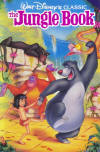 The
Jungle Book
(1967) This movie’s chief claim to fame is that it was the last one
produced by Walt Disney. There are those who speculate that if it
had been a financial failure the studio might have ceased producing
animated features altogether. To me, it is a second step in the
decline of Disney animation that began with
The Sword in the Stone
and continued through the ‘70s and ‘80s, a long period of growing
mediocrity that would not be reversed until
Jeffrey
Katzenberg took over the animated features division and started
producing a string of masterpieces beginning with
The Little Mermaid
in 1989. Like Sword, there is nothing particularly
bad about it, but it lacks heart, is badly paced, and its
hero fails to generate much interest. (It also marks the beginning
of a period when I felt too grown up to see Disney animated films.
This lasted until
The Black Cauldron,
another disappointment.) And finally, it was released at a time when
much more adventurous, much hipper films—R-rated or even
X-rated—were being produced by the likes of
Ralph Bakshi
with Fritz the
Cat and
Heavy Traffic.
Disney films seemed hopelessly lame compared to that.
The
Jungle Book
(1967) This movie’s chief claim to fame is that it was the last one
produced by Walt Disney. There are those who speculate that if it
had been a financial failure the studio might have ceased producing
animated features altogether. To me, it is a second step in the
decline of Disney animation that began with
The Sword in the Stone
and continued through the ‘70s and ‘80s, a long period of growing
mediocrity that would not be reversed until
Jeffrey
Katzenberg took over the animated features division and started
producing a string of masterpieces beginning with
The Little Mermaid
in 1989. Like Sword, there is nothing particularly
bad about it, but it lacks heart, is badly paced, and its
hero fails to generate much interest. (It also marks the beginning
of a period when I felt too grown up to see Disney animated films.
This lasted until
The Black Cauldron,
another disappointment.) And finally, it was released at a time when
much more adventurous, much hipper films—R-rated or even
X-rated—were being produced by the likes of
Ralph Bakshi
with Fritz the
Cat and
Heavy Traffic.
Disney films seemed hopelessly lame compared to that.
The good news is, parts of it are excellent. The background art is sensational. The film is another step toward using celebrities as voices, a trend I have railed against, but the “names” here are not superstars like Mel Gibson or Meryl Streep. Phil Harris is Baloo the bear, Louis Prima is King Louie the orangutan (which don’t inhabit India, but never mind; he’s exceptionally well drawn and animated), Sebastian Cabot is Bagheera the black panther, Sterling Holloway is very good as Kaa, the snake (python? boa?), and George Sanders is absolutely brilliant as Shere Khan the tiger. Against these talents, Mowgli the wolf-boy, or man-cub, practically vanishes. Two of the songs, “The Bare Necessities” and “I Wan’na Be Like You” are catchy and cute and jazzy. Shere Khan is a triumph of menace, but my favorite character is Kaa, who is brilliantly animated, with coils of him appearing here and there and everywhere. He must be 100 feet long. There is also a quartet of vultures. One of them speaks with an accent that is distinctly Liverpudlian, and has a (rather disheveled) Beatles mop-top haircut. So later I learn that the Beatles’ manager, George Martin, was arranging for the Fab Four to actually voice the vultures, but John Lennon wasn’t into it. That surprised me. It seems like just the sort of thing he would have gone for.
There were the usual complaints about violating the source material. For once I’ve actually read some Kipling fables … but it was the wrong fables. I had a copy of Just So Stories when I was young. I remember “The Elephant’s Child,” which told of how the elephant got his trunk. The story is that Disney handed the book to the chief animator and said, "The first thing I want you to do is not read it." So the darker elements have been expunged, “Disneyfied,” and several characters are changed. Shere Khan is not killed, merely driven away by fire. Kaa was a friend to Mowgli in the book; in the film he spends all his time trying to eat him.
For once I don’t have to issue a PC warning about smoking. Nobody smokes here. But I do have to give a stupidity warning. There were some who objected to King Louie as an offensive racial stereotype. What the …? They’re saying he was supposed to be a Negro? But he’s not black, he’s orange. He’s a monkey, for chrissake (actually, an ape). Did these idiots think he was speaking black dialect? That’s bullshit. He was speaking jazz, jive, hepcat, and that’s spoken by both blacks and whites, from Duke Ellington to Lord Buckley. He was voiced by Louis Prima, an Italian. I think those critics were revealing their own racism by seeing a jive-talking monkey, eating bananas and living in the jungle and immediately thinking … Jungle equals Negro! Racism! Fuck ‘em.
Reality check: These observations are offered in the spirit of fun. I know an animated cartoon needn’t stick to logic or reality in any form. But … Mowgli, raised by wolves, never having come into contact with humans, at the age of about ten seems to have figured out for himself how to make a pair of shorts. And sees the need to wear them. There are the usual predator/prey issues; Bagheera would certainly have eaten the abandoned infant rather than take him to the wolves … who also would have eaten him, the Romulus and Remus legend notwithstanding. A little more seriously, at the very end Mowgli comes to the man village and sees a young woman drawing water in a jug. He’s dazzled. She’s flirty … and also has a little red dot on her forehead that, I believe, indicates she is of the Brahmin caste. Mowgli, as a casteless foundling, raised by wolves … what would he be? By default I expect he’d be an untouchable. Which would put the girl sadly out of bounds. Forever. Oh, well, back to the jungle, maybe he’ll have better luck with the monkeys …IMDb.com
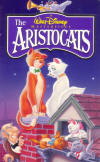 The
AristoCats
(1970) Possibly the worst of the Disney animated features. I’ll have
to see Robin
Hood to be sure, something I’m not really looking
forward to. Plot: A rich old bitch makes her will leaving all her
money to her four cats, a mama and her three annoying kittens. After
the cats are dead, the money would go to her butler, Edgar. Now
imagine Edgar, overhearing this, doing the math. Now imagine
yourself thinking it all over …
The
AristoCats
(1970) Possibly the worst of the Disney animated features. I’ll have
to see Robin
Hood to be sure, something I’m not really looking
forward to. Plot: A rich old bitch makes her will leaving all her
money to her four cats, a mama and her three annoying kittens. After
the cats are dead, the money would go to her butler, Edgar. Now
imagine Edgar, overhearing this, doing the math. Now imagine
yourself thinking it all over …
You’re not ruthless enough? Well, I am. I will admit to certain prejudices here, such that this movie had almost nothing of interest to me. I don’t much care for cats, especially ones voiced by Eva Gabor, who I have no use for. In fact I can’t stand the whole Gabor clan. I don’t much care for rich bitches. I despise the idea that a crazy rich bitch can leave a fortune to a goddam dog or cat. (I am a dog lover, but that’s ridiculous.) Brother, those cats would have been dog food real fast if I were Edgar. Which is, of course, what he sets out to do. The helpless, abandoned felines are left in the country and guided home by O’Malley the alley cat (Phil Harris), with pretty boring adventures along the way. They meet some annoying geese, and spend some time with an annoying cat jazz band singing an embarrassingly bad song called “Ev’rybody Wants to Be a Cat.” (I don’t.) By 1970 the Disney people’s idea of jazz was about 30 years out of date, and besides, we were all listening to rock by then. As if that weren’t enough, the movie is introduced with Maurice Chevalier, my least favorite French singer (I only know two others) singing the theme song.
Is there anything good here? Well, not the animation. It is dull and unoriginal. Not the music. Not the plot. Not the characters. The only ones I liked were poor old Edgar, and two French country hound dogs who—inexplicably but humorously—speak like Arkansas hillbillies. The Bloodhound is voiced by Pat Buttram (Gene Autry’s old sidekick), and the Bassett hound is George Lindsey (Goober Pyle). They have several slapstick encounters with Edgar, and they are the high point of the movie, which isn’t saying much.
And I have several times been amused to point out some feel-good silliness when it comes to interactions between animals in animated movies, such as the idea that Tramp would be a faithful father to Lady’s pups, or that Simba the lion in The Lion King would be happy to eat grubs and worms—which apparently have no feelings. Here the cats seem to eat nothing but cream. Okay, it’s animated comedy, it’s for kids. And when O’Malley and Duchess are seemingly “married” here, nobody asks where the first litter came from. Run over by a Peugeot, or simply ran off? Well, I’ll let that one go by, too. But I have to put my foot down when it comes to the “best friend” of these cats. It’s a mouse. I’m afraid that’s too much suspension of disbelief. Cats eat mice. End of story. If you don’t believe me, ask Tom and Jerry. IMDb.com
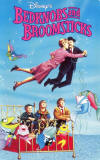 Bedknobs
and Broomsticks
(1971) This is the 26th film we’ve watched in our marathon Disney
animation festival, and the first one I hadn’t already seen. It will
be 23 more until we reach another I haven’t seen:
Atlantis: The Lost
Empire.
Bedknobs
and Broomsticks
(1971) This is the 26th film we’ve watched in our marathon Disney
animation festival, and the first one I hadn’t already seen. It will
be 23 more until we reach another I haven’t seen:
Atlantis: The Lost
Empire.
It was based on two books by Mary Norton—The Magic Bedknob; or, How to Become a Witch in Ten Easy Lessons, and Bonfires and Broomsticks—and as usual the Disney organization took what they wanted and changed what they wanted. It is the story of Eglantine Price, an “apprentice witch” (Angela Lansbury) who is taking magic lessons via mail, and three children evacuated from London to the countryside during World War II. Some of her spells work, and some don’t, and some are simply forgotten because her memory is bad. She manages to enchant a bedknob such that the bed will take them anywhere they want to go. They travel to London, where the meet Professor Emelius Brown (David Tomlinson), the man who had been selling Eglantine her lessons, and find out he is a street illusionist and con man, then to the Isle of Naboombu, where animals talk. Later, they foil a small raiding party of Nazis who come ashore from a submarine. The major changes are that in the book the island was inhabited by cannibals, and there were no Nazis.
This movie has a rather sad history. It was to be a major deal, like Mary Poppins, but for some reason was shortened from two and a half hours to just under two hours. Three songs were cut, a sub-plot with Roddy McDowall was eliminated, and the biggest (and by far the best) musical number, “Portobello Road,” was shortened by six minutes. Then, in 1997, Disney decided to reconstruct as much as they could of the original movie, and that version is available on DVD.
I considered renting that DVD, but I decided I didn’t like it enough to see the whole thing again, plus half an hour. It might have been better with Julie Andrews, who was considered for the starring role. But as it is, the movie lacks heart and any sense of danger. I didn’t like the kids, especially the smart-ass oldest one. The animated part on the island is not very well done. Most of it concerns a soccer match, and some parts of it reminded me of Hanna-Barbera television shows, where Yogi Bear or Fred Flintstone run in place over an endless, repeating background. Knockabout farce and little else. The Nazi part feels added on, as it indeed was, though the battle between the Germans and the magically-animated empty suits of armor are the most arresting visual images, and probably looked even better in 1971. The journeys on the magic bed are psychedelic light shows that aren’t very interesting, though if you look closely you will see some solarized landscapes very much like those at the end of 2001: A Space Odyssey, which is surely where the filmmakers stole them. IMDb.com
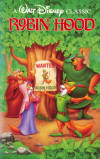 Robin
Hood
(1973) Disney made a lot of feature-length animated masterpieces,
some movies that were merely competent, and a few that were not very
good. Here we have the absolute nadir, the rock bottom of the long
decline that began with The
Sword in the Stone and didn’t really end until
The Little Mermaid.
Absolutely everything about this movie is wrong,
wrong, wrong. The animation was done on the cheap. Not quite
Hanna-Barbera
level, but close. Whose brilliant idea was it to have most of these
English animals speak with some Arkansas cornpone hillbilly accents?
I love Roger Miller and
his music, but it was horribly out of place here. All
the voices are badly cast. All the classic
Robin Hood tales
are either omitted or screwed up. This movie was so bad it was a
real chore to get through it, and I won’t waste any more of my time
or yours on it.
IMDb.com
Robin
Hood
(1973) Disney made a lot of feature-length animated masterpieces,
some movies that were merely competent, and a few that were not very
good. Here we have the absolute nadir, the rock bottom of the long
decline that began with The
Sword in the Stone and didn’t really end until
The Little Mermaid.
Absolutely everything about this movie is wrong,
wrong, wrong. The animation was done on the cheap. Not quite
Hanna-Barbera
level, but close. Whose brilliant idea was it to have most of these
English animals speak with some Arkansas cornpone hillbilly accents?
I love Roger Miller and
his music, but it was horribly out of place here. All
the voices are badly cast. All the classic
Robin Hood tales
are either omitted or screwed up. This movie was so bad it was a
real chore to get through it, and I won’t waste any more of my time
or yours on it.
IMDb.com
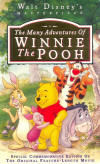 The
Many Adventures of Winnie the Pooh
(1977) Here, for once, is a Disney movie about whose source material
I am intimately familiar. When I Was Very Young we had both
Winnie-the-Pooh and
The
House at Pooh Corner on our bookshelf, and my mother
used to read them to me at bedtime, along with a few other favorites
like
Mike Mulligan and His Steam Shovel. I’m pretty sure that
I could read them myself at some point, and I know I had most of the
stories memorized, but I still wanted her to read them. What I
remember most is the story about Pooh and Piglet building a trap for
Heffalumps and baiting it with a jar of honey. Pooh obsessed about
the honey all night, and finally got up and went down in the trap to
eat it. He got the jar stuck on his head, and when Piglet came to
check the trap he saw Pooh down there and ran away, screaming
“Help, help, a Heffalump, a Horrible Heffalump! Help, help, a
Herrible Hoffalump! Hoff, hoff, a Hellible Horralump! Holl, holl, a
Hoffable Hellerump!” And I would laugh hysterically every
time my mother read that.
The
Many Adventures of Winnie the Pooh
(1977) Here, for once, is a Disney movie about whose source material
I am intimately familiar. When I Was Very Young we had both
Winnie-the-Pooh and
The
House at Pooh Corner on our bookshelf, and my mother
used to read them to me at bedtime, along with a few other favorites
like
Mike Mulligan and His Steam Shovel. I’m pretty sure that
I could read them myself at some point, and I know I had most of the
stories memorized, but I still wanted her to read them. What I
remember most is the story about Pooh and Piglet building a trap for
Heffalumps and baiting it with a jar of honey. Pooh obsessed about
the honey all night, and finally got up and went down in the trap to
eat it. He got the jar stuck on his head, and when Piglet came to
check the trap he saw Pooh down there and ran away, screaming
“Help, help, a Heffalump, a Horrible Heffalump! Help, help, a
Herrible Hoffalump! Hoff, hoff, a Hellible Horralump! Holl, holl, a
Hoffable Hellerump!” And I would laugh hysterically every
time my mother read that.
This is a movie for very young children. It’s actually made from four short movies, which were later stitched together into one feature. The attractions for an adult are limited. But they got a lot of things right. The look of the characters is reasonably close to the classic illustrations in the books. (The thing I like best about the Disney treatment is that transitions are accomplished by having the characters skip from page to page of an actual book, leaping over the crease in the middle. Sometimes the words wash away in water, or crumble down the page.) The best characters are Piglet and Eeyore, whose mannerisms and voices are perfect. I didn’t like Sterling Holloway as the voice of Pooh. Christopher Robin has been modernized a little. I remember thinking his clothes were odd when I was young. It almost looked like he was wearing dresses, though he had short pants under them. And boys were sometimes attired in dresses in the Victorian Age and later.
The worst characters in terms of faithfulness are Owl and Rabbit. Owl is too gay when he should be solemn, and Rabbit is too nervous. My least favorite character in all respects, in both books and film, is Tigger, who is a noisy pain in the ass, but I’m sure the Very Young love him.
The stories are handled reasonably well, though sometimes they forget about the payoff, as when Pooh and Piglet are tramping round and round a spinney of trees, possibly on the track of a Woozle, and the footprints of other creatures, one large and one small, keep joining the track until it seems they are following a whole band of Woozles. We need the scene where Christopher Robin points out that all the tracks are their own, and we don’t get it. IMDb.com
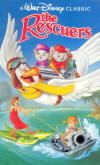 The
Rescuers
(1977) The Rescue Aid Society is located in the floorboards of the
United Nations, and exists to find children in trouble and deal with
their situation. All the members are mice. Miss Bianca picks, for
some unknown reason, the janitor to accompany her to the bayou
country to rescue a little girl kidnapped from an orphanage by
Madame Medusa, who needs the child to recover some pirate treasure.
They fly south in a sardine can attached to the back of an
albatross.
The
Rescuers
(1977) The Rescue Aid Society is located in the floorboards of the
United Nations, and exists to find children in trouble and deal with
their situation. All the members are mice. Miss Bianca picks, for
some unknown reason, the janitor to accompany her to the bayou
country to rescue a little girl kidnapped from an orphanage by
Madame Medusa, who needs the child to recover some pirate treasure.
They fly south in a sardine can attached to the back of an
albatross.
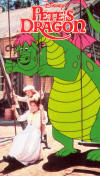 Pete’s
Dragon
(1977) Disney really wanted another
Mary Poppins, and made two more attempts at live-action
musicals with animation. The first was
Bedknobs and Broomsticks,
which was amusing but uninspired. This was the second, and it’s not
much. It’s full of sometimes amusing slapstick, but that’s about all
it has. The songs are not memorable except for one, “Candle
on the Water,” which was nominated for an Oscar. The
movie is altogether too boisterous, and never involved me in any of
the characters. Pete never really comes alive, he’s played by a boy
actor with no talent for either singing or acting. Elliot, the
dragon, seems to fluctuate amazingly in size, but then I guess a
magic dragon can do whatever he wants to. He’s too goofy to be very
interesting. He bears a kinship with the critter in
The Reluctant Dragon,
who I also didn’t like. As for the headliner star,
Helen Reddy …
well, Angela
Lansbury proved she was no
Julie Andrews,
and Helen Reddy is not even Angela Lansbury. She has no screen
presence. She has a pleasant voice, and that’s the best I can say
for her. Mickey
Rooney (real name, Joseph Yule, Jr.) and
Red Buttons
(Aaron Chwatt) overdo the drunk act, and a little bit of Buttons
stammering and shivering in fear goes a long way. We get a lot
of that. (Side note: Did you know Mickey Rooney is still alive,
going strong at 90? And he’s been in show biz for 88½ of those
years. Trivia: His marriage to his current wife has lasted longer
than his previous seven marriages combined. Eighth
time’s the charm, I guess.) It’s not a terrible movie, it’s just not
put together well. About the best thing in it is
Shelley
Winters as a hillbilly mother.
IMDb.com
Pete’s
Dragon
(1977) Disney really wanted another
Mary Poppins, and made two more attempts at live-action
musicals with animation. The first was
Bedknobs and Broomsticks,
which was amusing but uninspired. This was the second, and it’s not
much. It’s full of sometimes amusing slapstick, but that’s about all
it has. The songs are not memorable except for one, “Candle
on the Water,” which was nominated for an Oscar. The
movie is altogether too boisterous, and never involved me in any of
the characters. Pete never really comes alive, he’s played by a boy
actor with no talent for either singing or acting. Elliot, the
dragon, seems to fluctuate amazingly in size, but then I guess a
magic dragon can do whatever he wants to. He’s too goofy to be very
interesting. He bears a kinship with the critter in
The Reluctant Dragon,
who I also didn’t like. As for the headliner star,
Helen Reddy …
well, Angela
Lansbury proved she was no
Julie Andrews,
and Helen Reddy is not even Angela Lansbury. She has no screen
presence. She has a pleasant voice, and that’s the best I can say
for her. Mickey
Rooney (real name, Joseph Yule, Jr.) and
Red Buttons
(Aaron Chwatt) overdo the drunk act, and a little bit of Buttons
stammering and shivering in fear goes a long way. We get a lot
of that. (Side note: Did you know Mickey Rooney is still alive,
going strong at 90? And he’s been in show biz for 88½ of those
years. Trivia: His marriage to his current wife has lasted longer
than his previous seven marriages combined. Eighth
time’s the charm, I guess.) It’s not a terrible movie, it’s just not
put together well. About the best thing in it is
Shelley
Winters as a hillbilly mother.
IMDb.com
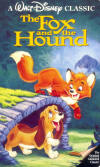 The
Fox and the Hound
(1981) This film is a big step upward from the nadir of Disney
animation reached in Robin Hood
eight years before. They’re not quite back to “classic” level, but
they’re making progress. They spent serious money on this
one—$12,000,000, the most expensive animated film produced up to
that time—and it shows. The art work is lovely, much of it
reminiscent of the best of Bambi
and other forest environments like
The Jungle Book, and the animation is miles
better than what they had been producing before. There is a scene
where a bear is disturbed, and it is one scary bear.
The story is pretty good, but it didn’t really resonate with me as
much as it did the first time I saw it, when it was new. It is often
cited as having a theme of prejudice and its evils, but I don’t
really see it. The fact is that foxes and hounds are natural
enemies. Though these two grew up together, it wouldn’t make sense
for the friendship to last … and it doesn’t, though the memory of
the friendship ends up saving the life of the fox when the mature
hunting hound protects him. To me, the moral might be that it’s a
mistake to domesticate foxes, or any wild animals. To my knowledge,
foxes don’t make good pets, not even as good as ferrets or raccoons.
IMDb.com
The
Fox and the Hound
(1981) This film is a big step upward from the nadir of Disney
animation reached in Robin Hood
eight years before. They’re not quite back to “classic” level, but
they’re making progress. They spent serious money on this
one—$12,000,000, the most expensive animated film produced up to
that time—and it shows. The art work is lovely, much of it
reminiscent of the best of Bambi
and other forest environments like
The Jungle Book, and the animation is miles
better than what they had been producing before. There is a scene
where a bear is disturbed, and it is one scary bear.
The story is pretty good, but it didn’t really resonate with me as
much as it did the first time I saw it, when it was new. It is often
cited as having a theme of prejudice and its evils, but I don’t
really see it. The fact is that foxes and hounds are natural
enemies. Though these two grew up together, it wouldn’t make sense
for the friendship to last … and it doesn’t, though the memory of
the friendship ends up saving the life of the fox when the mature
hunting hound protects him. To me, the moral might be that it’s a
mistake to domesticate foxes, or any wild animals. To my knowledge,
foxes don’t make good pets, not even as good as ferrets or raccoons.
IMDb.com
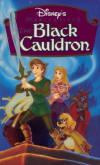 The
Black Cauldron
(1985) This was an experiment, a movie at least a decade ahead of
its time, and like several Disney experiments going all the way back
to Fantasia, it was a failure.
There have always been scary scenes in Disney animation, but few
images of real horror. The only one I can think of is the “Night
on Bald Mountain” sequence from Fantasia,
from which the artists on this one stole liberally. This movie is
chock full of that sort of image, even after the new head of
animation,
Jeffrey Katzenberg, actually cut some scenes he deemed too
strong. You hardly ever cut scenes from an animated
movie, there are no outtakes (no matter what
Pixar would have you believe),
because each scene is so carefully planned. It was widely condemned
as too ugly, too violent, too gory … too much of a lot of things,
which is really laughable today, where children see images 1000
times as violent and horrific all the time. Such a difference 25
years of moral degeneration can make. That said, this movie is no
Fantasia. It was adapted from a series of books called
Chronicles of Prydain, and there is simply too much plot
and not enough time to do justice to it. I didn’t find any of the
characters to be very engaging except for a little bug-eyed troll,
the toadying servant of the Horned King. One of them, a minstrel
named Fflewddur Fflam, just seems to appear for no reason at all
except that he was in the book, does pretty much nothing at all, and
is about as superfluous and unfunny as a comic character can be.
Another, a fuzzy thing called Gurgi, is quite annoying. This movie
is noteworthy mainly as the first use of computer animation by the
Disney studios. Some of it looks pretty good, and some of it sucks.
IMDb.com
The
Black Cauldron
(1985) This was an experiment, a movie at least a decade ahead of
its time, and like several Disney experiments going all the way back
to Fantasia, it was a failure.
There have always been scary scenes in Disney animation, but few
images of real horror. The only one I can think of is the “Night
on Bald Mountain” sequence from Fantasia,
from which the artists on this one stole liberally. This movie is
chock full of that sort of image, even after the new head of
animation,
Jeffrey Katzenberg, actually cut some scenes he deemed too
strong. You hardly ever cut scenes from an animated
movie, there are no outtakes (no matter what
Pixar would have you believe),
because each scene is so carefully planned. It was widely condemned
as too ugly, too violent, too gory … too much of a lot of things,
which is really laughable today, where children see images 1000
times as violent and horrific all the time. Such a difference 25
years of moral degeneration can make. That said, this movie is no
Fantasia. It was adapted from a series of books called
Chronicles of Prydain, and there is simply too much plot
and not enough time to do justice to it. I didn’t find any of the
characters to be very engaging except for a little bug-eyed troll,
the toadying servant of the Horned King. One of them, a minstrel
named Fflewddur Fflam, just seems to appear for no reason at all
except that he was in the book, does pretty much nothing at all, and
is about as superfluous and unfunny as a comic character can be.
Another, a fuzzy thing called Gurgi, is quite annoying. This movie
is noteworthy mainly as the first use of computer animation by the
Disney studios. Some of it looks pretty good, and some of it sucks.
IMDb.com
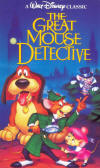 The
Great Mouse Detective
(1986) Now we finally make some real progress at getting out of the
abyss Disney animation descended into during the ‘80s with crap like
The Aristocats and
Robin Hood. While nobody is
likely to put this on a Best Of list, it’s a quite nice little story
with good characterization, good art, good humor, and an engaging
story. Basil lives at 221 Baker Street, just under 221B, where
Sherlock Holmes and Doctor Watson live. (In fact, in a brief scene
we see Holmes cast a shadow on a wall as he leaves to fight crime,
and he is voiced by none other than
Basil Rathbone!)
He is just as smart and dogged and scientific as Sherlock, though
not quite as stand-offish. The plot involves a diabolical evil
scheme to replace the (mouse) Queen with a mechanical substitute who
will turn all power over to Ratigan—a rat trying to pass himself off
as a mouse. Ratigan is delightfully voiced by Vincent Price, and he
has a pegleg bat henchman named Fidget who acts a lot like the troll
henchman in The Black Cauldron. He is voiced by
Candy Candido,
who did a lot of deep voices for Disney and others, and he’s pretty
funny. (Researching him, I found out he used to be on the
Jimmy Durante
radio show, where he had a catch phrase: “I’m feeling mighty low.” I
couldn’t find a recording of it.) There’s music by
Henry Mancini
and a song by Melissa
Manchester. There is also a very early CGI sequence, a chase
through the gears of Big Ben. CGI was so primitive back then that
they used it to make line drawings of the complex setting, printed
those drawings out, and then colored them by hand. My, how times
have changed.
IMDb.com
The
Great Mouse Detective
(1986) Now we finally make some real progress at getting out of the
abyss Disney animation descended into during the ‘80s with crap like
The Aristocats and
Robin Hood. While nobody is
likely to put this on a Best Of list, it’s a quite nice little story
with good characterization, good art, good humor, and an engaging
story. Basil lives at 221 Baker Street, just under 221B, where
Sherlock Holmes and Doctor Watson live. (In fact, in a brief scene
we see Holmes cast a shadow on a wall as he leaves to fight crime,
and he is voiced by none other than
Basil Rathbone!)
He is just as smart and dogged and scientific as Sherlock, though
not quite as stand-offish. The plot involves a diabolical evil
scheme to replace the (mouse) Queen with a mechanical substitute who
will turn all power over to Ratigan—a rat trying to pass himself off
as a mouse. Ratigan is delightfully voiced by Vincent Price, and he
has a pegleg bat henchman named Fidget who acts a lot like the troll
henchman in The Black Cauldron. He is voiced by
Candy Candido,
who did a lot of deep voices for Disney and others, and he’s pretty
funny. (Researching him, I found out he used to be on the
Jimmy Durante
radio show, where he had a catch phrase: “I’m feeling mighty low.” I
couldn’t find a recording of it.) There’s music by
Henry Mancini
and a song by Melissa
Manchester. There is also a very early CGI sequence, a chase
through the gears of Big Ben. CGI was so primitive back then that
they used it to make line drawings of the complex setting, printed
those drawings out, and then colored them by hand. My, how times
have changed.
IMDb.com
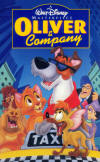 Oliver
and Company
(1988) The Disney take on
Oliver Twist,
set in present-day New York City. Oliver is an abandoned kitten.
Dodger (voiced and sung by Billy Joel) is a streetwise mutt, leader
of a gang of stray dogs. Fagin is a human bum (voiced by
Dom DeLuise)
who is in debt to Sykes, a loan shark who drives a big black
Cadillac and has two Dobermans named DeSoto and Roscoe. All the dogs
are quite well characterized, with the star being
Cheech Marin
as Tito, who is absolutely like every Chihuahua you’ve ever met:
hyperactive, mouthy, insanely fearless in spite of his size, and
with a high opinion of himself. Francis, the English bulldog, is
voiced by
Roscoe Lee Browne. There are also cameo appearances by mutts
from Lady and the Tramp
and One Hundred and One
Dalmatians. As in the novel, Oliver is taken into a
wealthy home. Unlike the novel, the dogs think they are “rescuing”
him, instead of taking him back because he knows too much. He’s
loved by the little girl in the 5th Avenue mansion, but not by the
resident Best of Show poodle, Georgette (Bette
Midler), who schemes to get rid of the little furball. It all
works well, from story to art to characters.
Oliver
and Company
(1988) The Disney take on
Oliver Twist,
set in present-day New York City. Oliver is an abandoned kitten.
Dodger (voiced and sung by Billy Joel) is a streetwise mutt, leader
of a gang of stray dogs. Fagin is a human bum (voiced by
Dom DeLuise)
who is in debt to Sykes, a loan shark who drives a big black
Cadillac and has two Dobermans named DeSoto and Roscoe. All the dogs
are quite well characterized, with the star being
Cheech Marin
as Tito, who is absolutely like every Chihuahua you’ve ever met:
hyperactive, mouthy, insanely fearless in spite of his size, and
with a high opinion of himself. Francis, the English bulldog, is
voiced by
Roscoe Lee Browne. There are also cameo appearances by mutts
from Lady and the Tramp
and One Hundred and One
Dalmatians. As in the novel, Oliver is taken into a
wealthy home. Unlike the novel, the dogs think they are “rescuing”
him, instead of taking him back because he knows too much. He’s
loved by the little girl in the 5th Avenue mansion, but not by the
resident Best of Show poodle, Georgette (Bette
Midler), who schemes to get rid of the little furball. It all
works well, from story to art to characters.
There is a production number with Georgette that I think had a lot of influence on the real Disney renaissance, which was just around the corner. There is a distinct Broadway flavor to it, and it reminded me of “Under the Sea” from The Little Mermaid and “Be Our Guest” from Beauty and the Beast. (Interestingly enough, both those movies were later turned into Broadway musicals.) It was the Broadway musical influence from the new faces at Disney—most importantly Alan Menken and Howard Ashman—who mostly came from a theater background, that was the real spark that boosted the coming films back to the level of the classics of the ‘40s and ‘50s.
CGI was used much more extensively here than in The Great Mouse Detective, though it was still in the stage where it was only useful for geometric, inanimate objects like buildings and cars. The New York City settings are great, and three-dimensional in a way quite different from the old multi-plane camera. CGI enabled the animators to save huge amounts of time, moving through a 3D landscape. And even here those 19 sub-humans of September 11 are able to reach out and hurt me. Several shots of Lower Manhattan feature the World Trade Center. IMDb.com
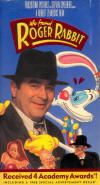 Who
Framed Roger Rabbit
(1988) I would have sworn there was a question mark at the end of
this title, but there isn’t. That got me to wondering, why not. It’s
based on a novel Who Censored Roger Rabbit? by Gary K.
Wolf: who knows how to punctuate? I came up with three possible
explanations:
Who
Framed Roger Rabbit
(1988) I would have sworn there was a question mark at the end of
this title, but there isn’t. That got me to wondering, why not. It’s
based on a novel Who Censored Roger Rabbit? by Gary K.
Wolf: who knows how to punctuate? I came up with three possible
explanations:
1. It’s not a question, it’s the solution. Roger Rabbit was framed by Who. You know, Who, the first baseman in Abbott and Costello’s classic “Who’s on First” routine.
2. Same as above, but it’s a mispeling. Roger was framed by Hu Jintao, the President of China. Hu Framed Roger Rabbit. The damn Red Chinese, that’s hu.
3. My own choice: It’s the poster art. When talking about the movie to their friends, they knew people weren’t going to say “Did you see Who Framed Roger Rabbit.” They would say, “Did you see Roger Rabbit.” When you look at the poster, that’s what you see. It’s only on second glance that you realize it is
Who Framed
Roger Rabbit
Aren’t you glad to have that finally explained.
Movies don’t get much better than this. It’s 22 years old now, and it’s astonishing how they did all this with no computers. (Well, not during the principle photography and the addition of animation, though Industrial Light and Magic did some SFX tinkering later involving light and shadowing and layering of textures to make the toons more 3D.) You could probably watch it 20 times and still see things you missed when you watched it the 21st time. It is jammed full of insider jokes, references to other movies and other cartoons, and it contains appearances from just about every toon who ever graced a cel at the Walt Disney Studios and the Warner Brothers’ Termite Terrace, as well as cameos by stars like Betty Boop (out of work since cartoons went to color) and Woody Woodpecker. I didn’t see Tom and Jerry from the MGM animation department, but I wouldn’t be surprised to find out they were there. Droopy Dog had a small role, and he was created by Tex Avery at MGM. Avery strongly influenced all the kinetic action scenes, particularly the business he would do with bulging eyeballs when a character was frightened or astonished. The story is strong, and so are the production values, such as the creation of the old Red Cars, which Cloverleaf Corporation is buying up so they can tear them out and replace them with freeways.
There has been talk for years about a sequel, and everyone involved seemed to be interested at one point or another, but nothing has happened. I guess it’s in development hell. I’m ambivalent. I’d like to see more, but that’s so often a bad idea. The DVD contains a “making of” featurette and three Maroon Cartoons: “Tummy Trouble,” “Roller Coaster Rabbit,” and “Trail Mix-up.” IMDb.com
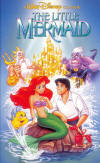 The
Little Mermaid
(1989) I think most critics would name
Beauty and the Beast as the best of the “Disney
Renaissance” titles of the 1990s. I wouldn’t argue with them, but my
personal favorite is this one. As usual I am unencumbered by any
love for the source material. I had never read the
Hans
Christian Andersen story. I just now read a
summary on
Wikipedia, and gad, what an awful story! The mermaid not only
can’t speak, but she walks around as if on sharp swords all the
time. (I really sympathize; because I do, too.) The
Prince is not enchanted by the Sea Witch, he really
does fall in love with another woman who he thinks saved
him from drowning, and marries her. The Little Mermaid is offered an
out: If she kills the Prince, her One True Love, and drips his blood
on her feet, she will become a mermaid again and be free of pain.
Naturally, she doesn’t, but in a “happy ending,” she becomes a
creature of the air, and can gain an eternal soul (apparently mer-critters
don’t have one) and be eventually united with God. Even without the
religious bullshit, it’s a terrible story. Well, you
know those old fairy tales could be pretty damn grimm.
The
Little Mermaid
(1989) I think most critics would name
Beauty and the Beast as the best of the “Disney
Renaissance” titles of the 1990s. I wouldn’t argue with them, but my
personal favorite is this one. As usual I am unencumbered by any
love for the source material. I had never read the
Hans
Christian Andersen story. I just now read a
summary on
Wikipedia, and gad, what an awful story! The mermaid not only
can’t speak, but she walks around as if on sharp swords all the
time. (I really sympathize; because I do, too.) The
Prince is not enchanted by the Sea Witch, he really
does fall in love with another woman who he thinks saved
him from drowning, and marries her. The Little Mermaid is offered an
out: If she kills the Prince, her One True Love, and drips his blood
on her feet, she will become a mermaid again and be free of pain.
Naturally, she doesn’t, but in a “happy ending,” she becomes a
creature of the air, and can gain an eternal soul (apparently mer-critters
don’t have one) and be eventually united with God. Even without the
religious bullshit, it’s a terrible story. Well, you
know those old fairy tales could be pretty damn grimm.
There are many reasons why this movie stands out as one of the very best, and certainly by far the best in thirty years. The animation is outstanding in every respect, from color palette to spatial relationships to characterization. Once again early CGI facilitated moves through space that would have been too expensive, difficult, or time-consuming, and they are used to good emotional and dramatic effect. The characters of Ursula and Sebastian are terrific. Ursula in particular oozes through her scenes like the octopus she is, and alternates between bitchy humor and terrifying evil. She ranks right up there with Maleficent and the great Cruella. Sebastian is voiced perfectly, and his facial expressions are wonderfully drawn. But the movie really does belong to that rebellious, wide-eyed, innocent romantic, Ariel. She sings so well that it’s a shame she is mute for half the picture. And animators have seldom made a character live so completely. Her expressions are a joy to behold. I fell in love with her, fishtail and all. And as for when she is transformed into a real girl, but one who can’t speak … this is a problem? (Kidding.)
But the biggest thing here is, of course, the music by Alan Menken and Howard Ashman. I’ve sort of wondered how they got the job over more established songwriting teams. At the time they were known only for an off-Broadway show called Little Shop of Horrors, which is brilliant, but not all that well-known at the time. For whatever reason, they did get hired, and were influential in turning The Little Mermaid (which, I am astonished to learn, was once Walt’s choice as the next film to make after Snow White and the Seven Dwarfs!) into a Broadway musical. Emphasis on Broadway. Disney animated films have always had music, some of it really great, but never anything like this. All of it is great, but the stroke of genius is “Under the Sea” (Oscar for Best Song), which is a production number. That is, a moment when the whole cast, all the chorus, all the dancers, all the bells and whistles available to the theatrical director are assembled on stage at once, and all the stops are pulled out. It set the stage for “Be Our Guest” in Beauty and the Beast, and many others including half a dozen in Disney’s most recent, The Princess and the Frog. This movie and three of the next four (Beauty and the Beast, The Lion King, and Aladdin) were all retrofitted and actually became stage musicals over the next twenty years. I wouldn’t be a bit surprised if The Princess and the Frog became one, too. IMDb.com
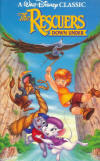 The
Rescuers Down Under
(1990) This was Disney’s first animated sequel until
Fantasia 2000,
which was not really a sequel but a continuation, as Walt had first
envisioned it. (I’m not counting those now innumerable
direct-to-video things. I haven’t seen any of them, and I don’t
intend to. I mean, Bambi II? Cinderella III: A Twist in Time?
Lady and the Tramp II: Scamp’s Adventure? Beauty and the Beast: The
Enchanted Christmas? Give me a break.) I wondered why a
sequel to this particular one, The
Rescuers, a rather routine entry in the canon, then I
realized it made a certain sense. It lends itself to The Further
Adventures of … since the Rescue Aid Society can be assumed to have
lots of missions to carry out. Same with
The Great Mouse Detective.
Basil would have new cases to solve. Most of the others come to a
conclusion that seems emotionally satisfying, which is why I’m not
interested in The Lion King 1½. (Yes, there really is
such a thing.) This one is about on the same level as the first one,
and I still have my same objections to
Bob Newhart
and Eva Gabor
as the voices of animated characters.
John Candy has
replaced Jim Jordan,
who retired, as the albatross airline. The film looks very good,
with interesting backgrounds and great color. Much of it is very
clever and inventive A lot of early CGI was used to more easily give
three-dimensional effects, and there are many more swooping,
careening, Star Wars kind of shots than in previous
films. The story is okay, and
George C.
Scott does a good job as the voice of the villain, but that
brings me to my chief objection. I guess Scott’s total lack of an
Aussie accent could be explained if he were an American who had
taken up residence in the Outback, but what about the kid? He grew
up there, and he sounds like a native of Omaha, Nebraska. Were they
afraid of using accents for the main characters? A kangaroo and a
kangaroo rat both speak as an Aussie should, but no one else does.
Damn it, the accents didn’t have to be as thick as
Crocodile Dundee, but it seems somehow insulting to dispense
with them entirely. One more thing … though this is obviously on a
fantasy level, what with animals talking to the boy and all, the
animals were pretty accurately drawn, and of normal size, except for
one. I had a little trouble with an eagle the size of a 747 with the
boy riding on his back.
IMDb.com
The
Rescuers Down Under
(1990) This was Disney’s first animated sequel until
Fantasia 2000,
which was not really a sequel but a continuation, as Walt had first
envisioned it. (I’m not counting those now innumerable
direct-to-video things. I haven’t seen any of them, and I don’t
intend to. I mean, Bambi II? Cinderella III: A Twist in Time?
Lady and the Tramp II: Scamp’s Adventure? Beauty and the Beast: The
Enchanted Christmas? Give me a break.) I wondered why a
sequel to this particular one, The
Rescuers, a rather routine entry in the canon, then I
realized it made a certain sense. It lends itself to The Further
Adventures of … since the Rescue Aid Society can be assumed to have
lots of missions to carry out. Same with
The Great Mouse Detective.
Basil would have new cases to solve. Most of the others come to a
conclusion that seems emotionally satisfying, which is why I’m not
interested in The Lion King 1½. (Yes, there really is
such a thing.) This one is about on the same level as the first one,
and I still have my same objections to
Bob Newhart
and Eva Gabor
as the voices of animated characters.
John Candy has
replaced Jim Jordan,
who retired, as the albatross airline. The film looks very good,
with interesting backgrounds and great color. Much of it is very
clever and inventive A lot of early CGI was used to more easily give
three-dimensional effects, and there are many more swooping,
careening, Star Wars kind of shots than in previous
films. The story is okay, and
George C.
Scott does a good job as the voice of the villain, but that
brings me to my chief objection. I guess Scott’s total lack of an
Aussie accent could be explained if he were an American who had
taken up residence in the Outback, but what about the kid? He grew
up there, and he sounds like a native of Omaha, Nebraska. Were they
afraid of using accents for the main characters? A kangaroo and a
kangaroo rat both speak as an Aussie should, but no one else does.
Damn it, the accents didn’t have to be as thick as
Crocodile Dundee, but it seems somehow insulting to dispense
with them entirely. One more thing … though this is obviously on a
fantasy level, what with animals talking to the boy and all, the
animals were pretty accurately drawn, and of normal size, except for
one. I had a little trouble with an eagle the size of a 747 with the
boy riding on his back.
IMDb.com
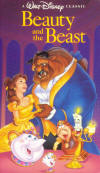 Beauty
and the Beast
(1991) Though I have a personal preference for
The Little Mermaid, there
is no doubt that this movie is the masterpiece of the Disney
Renaissance of the 1990s. It continues the Broadway structure
pioneered by The Little Mermaid, and also has songs by
Howard Ashman
and
Alan Menken.
(Sadly, Ashman died of AIDS before he could see this film. It has a
dedication at the end: “To our friend Howard, who gave a mermaid her
voice and a beast his soul, we will be forever grateful.”) It was
the first animated film to be nominated for Best Picture. (It lost
to The Silence
of the Lambs, which I don’t think is as good.) It was
later turned into a smash hit Broadway musical, which ran for 5,464
performances and is certainly playing somewhere on the planet at
this moment. The music is wonderful, the animation is wonderful, the
story is great … I can’t find a single thing to criticize about this
movie. It is also notable technically for increased use of CGI,
particularly in the famous ballroom scene where the camera swoops
through a chandelier and down to circle around the dancing couple.
Beauty
and the Beast
(1991) Though I have a personal preference for
The Little Mermaid, there
is no doubt that this movie is the masterpiece of the Disney
Renaissance of the 1990s. It continues the Broadway structure
pioneered by The Little Mermaid, and also has songs by
Howard Ashman
and
Alan Menken.
(Sadly, Ashman died of AIDS before he could see this film. It has a
dedication at the end: “To our friend Howard, who gave a mermaid her
voice and a beast his soul, we will be forever grateful.”) It was
the first animated film to be nominated for Best Picture. (It lost
to The Silence
of the Lambs, which I don’t think is as good.) It was
later turned into a smash hit Broadway musical, which ran for 5,464
performances and is certainly playing somewhere on the planet at
this moment. The music is wonderful, the animation is wonderful, the
story is great … I can’t find a single thing to criticize about this
movie. It is also notable technically for increased use of CGI,
particularly in the famous ballroom scene where the camera swoops
through a chandelier and down to circle around the dancing couple.
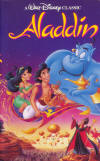 Aladdin
(1992)
This may not be the best of the decade-long Disney Renaissance, but
I think most people would agree that it’s the funniest. It barrels
right along, full of action and song, for the first third, doing
quite well, and then everything is amplified, ramped up a notch, and
thrown into anarchy by what is surely the biggest star turn in any
Disney animated feature: the appearance of
Robin Williams as the
Genie. I mean anarchy in the
best possible way. Animated features are never improvised, they are
scripted to a fare-thee-well. But not here. They gave him a plot
line, dialogue suggestions, and a microphone, and let him loose. The
result is an explosion of funny stuff that must have kept the
animators scrambling to keep up with the rapid-fire imagery. He did
impressions of around 50 people, from
Ed Sullivan
to
William F. Buckley to
Groucho Marx,
far too much to put into one movie, and the animators selected the
best of it all and did a brilliant job of caricaturing them. The
Genie is plastic, elastic, frenetic, kinetic, and always, always,
always funny. Williams anticipated the anachronistic tone of movies
that came later, like
Shrek, and
after at first being shocked, I was soon delighted. I think it’s
safe to say Aladdin wouldn’t have been half the movie
it is without Robin Williams.
Aladdin
(1992)
This may not be the best of the decade-long Disney Renaissance, but
I think most people would agree that it’s the funniest. It barrels
right along, full of action and song, for the first third, doing
quite well, and then everything is amplified, ramped up a notch, and
thrown into anarchy by what is surely the biggest star turn in any
Disney animated feature: the appearance of
Robin Williams as the
Genie. I mean anarchy in the
best possible way. Animated features are never improvised, they are
scripted to a fare-thee-well. But not here. They gave him a plot
line, dialogue suggestions, and a microphone, and let him loose. The
result is an explosion of funny stuff that must have kept the
animators scrambling to keep up with the rapid-fire imagery. He did
impressions of around 50 people, from
Ed Sullivan
to
William F. Buckley to
Groucho Marx,
far too much to put into one movie, and the animators selected the
best of it all and did a brilliant job of caricaturing them. The
Genie is plastic, elastic, frenetic, kinetic, and always, always,
always funny. Williams anticipated the anachronistic tone of movies
that came later, like
Shrek, and
after at first being shocked, I was soon delighted. I think it’s
safe to say Aladdin wouldn’t have been half the movie
it is without Robin Williams.
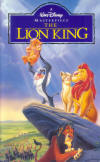 The
Lion King
(1994) The
most successful animated movie, ever, until
Finding Nemo
came along, and still by far the biggest earning hand-drawn feature.
It brought in $783,000,000 worldwide, which makes it #29 of the
all-time earners, and one of only six in the Top 30 that was made in
the 20th century. When you adjust for inflation and things like the
recent 3D surcharge, it’s probably higher than that. (But then, by
that measure, Snow
White and the Seven Dwarfs might be in the Top 5.)
The
Lion King
(1994) The
most successful animated movie, ever, until
Finding Nemo
came along, and still by far the biggest earning hand-drawn feature.
It brought in $783,000,000 worldwide, which makes it #29 of the
all-time earners, and one of only six in the Top 30 that was made in
the 20th century. When you adjust for inflation and things like the
recent 3D surcharge, it’s probably higher than that. (But then, by
that measure, Snow
White and the Seven Dwarfs might be in the Top 5.)
Okay, yeah, we’re all box-office crazy these days, right now everybody’s watching the numbers for Iron Man 2 as if they were close results of a presidential election, and as if it really mattered to anyone but studio execs and investors. But is the movie any good?
Yes, it is. It will never be my favorite, but the minute I heard the plot line and saw the opening 20 minutes, I knew this would appeal to kids who were still in the market for plush stuffed animals. That cute little lion cub pulled them in, and then they stayed for a more adult story inspired by, among other things, Hamlet. (Wiki says this was the first Disney feature that was not based on other source material, and though it seems incredible, I can’t find another. Dumbo was based on a toy, not a book or a story or a legend.) (And yeah, there are those who think it was ripped off from that awful Kimba the White Lion Japanimation thing. I choose to ignore them.) The animation is beautiful, and continues the trend toward CGI-aided compositions and action, particularly in the stampede of wildebeest, but it is still mostly hand-drawn. The songs are not as good as the previous few movies, and I didn’t really like “Hakuna Matata,” but that’s minor. The voice talent is all great, especially Nathan Lane as the meercat Timon. I didn’t recognize Matthew Broderick as Simba, nor Rowan Atkinson as the hornbill, but Whoopi Goldberg and Cheech Marin as hyenas were easy to spot. And it has what might be seen as a landmark: the first fart joke in a Disney animated feature.
In addition to the Kimba/Simba thing, this movie was so successful that it attracted more than its share of idiots with axes to grind … and one with a legitimate beef. The song “The Lion Sleeps Tonight” was used, apparently without permission from the composer’s family. Disney later settled with them. But then there was that asshole Donald Wildmon, who claimed the word SEX was spelled out in the stars in one scene, and the purpose was to corrupt people, subliminally, into wild orgies, probably homosexual. (Something is there—or was; Disney caved and altered the scene for home video. It is SFX, movie shorthand for special effects.) Does the idiocy of some people know no bounds? Apparently not. Another asshole sued the studio for defamation of character. Who did they defame? Why, spotted hyenas, that’s who. (If the hyenas had won, would Disney have paid off in rotting, stinking animal corpses?) Now, the hyena researchers who howled at the portrayal of their favorite African carnivores do have a point. All the other creatures in The Lion King are apparently a part of the great, friendly, “Circle of Life.” Though no one explained why that permitted lions to kill and eat zebras and antelope. Only the hyenas are shown as inherently evil. They are not evil, any more than any carnivore is. However … grow up! The word hyena has an association, and there’s nothing you can do about it, any more than you can take the stink out of the words rat, snake, polecat, skunk, vulture, Sarah Palin, or weasel. (Come to think of it, let’s file suit on behalf of all the weasels insulted in The Wind in the Willows.) These are characters in fables, idiots! In fables, foxes are smart and owls are wise, coyotes are tricky and snakes are sneaky. And hyenas are craven cowards. Let’s not even get into the accusations of racism in the casting of Whoopi and Cheech as hyenas … IMDb.com
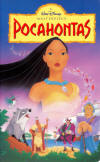 Pocahontas
(1995) Though this is as
colorful and visually interesting as any of the features from the
Disney Renaissance, it has always felt a little flat to me. The
music isn’t as good, nor are the big production numbers as
impressive as its predecessors, with the exception of a magical
sequence done to the best song in the picture, “The
Colors of the Wind.” (Oscar winner.) It’s all just
too solemn, as so many projects involving Indians seem to be. The
romance sort of almost works, but I can see why
younger children didn’t really take to this. Pocahontas’s little
slapstick animal friends, a raccoon and a hummingbird, are obviously
there to lighten things up a little—they were originally intended to
speak, and I’m glad they didn’t, in the end—but they seem imported
from another picture.
David
Ogden Stiers as the evil Governor is an effective villain. I
believe they wasted their money on
Mel Gibson as
John Smith; almost anyone in Hollywood could have done it. Though I
have to admit, it seems he did his own singing in his one number,
and he was a lot better than I would have expected.
Pocahontas
(1995) Though this is as
colorful and visually interesting as any of the features from the
Disney Renaissance, it has always felt a little flat to me. The
music isn’t as good, nor are the big production numbers as
impressive as its predecessors, with the exception of a magical
sequence done to the best song in the picture, “The
Colors of the Wind.” (Oscar winner.) It’s all just
too solemn, as so many projects involving Indians seem to be. The
romance sort of almost works, but I can see why
younger children didn’t really take to this. Pocahontas’s little
slapstick animal friends, a raccoon and a hummingbird, are obviously
there to lighten things up a little—they were originally intended to
speak, and I’m glad they didn’t, in the end—but they seem imported
from another picture.
David
Ogden Stiers as the evil Governor is an effective villain. I
believe they wasted their money on
Mel Gibson as
John Smith; almost anyone in Hollywood could have done it. Though I
have to admit, it seems he did his own singing in his one number,
and he was a lot better than I would have expected.
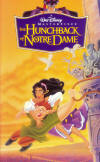 The
Hunchback of Notre Dame
(1996) Certainly the darkest of all the Disney features, and one of
the very best. When I say dark, I mean the subject matter, not the
look of the film, which explodes with color. We can see the
continuing evolution of CGI, which is in use a great deal here in
the backgrounds and the camera moves. The cathedral is beautifully
rendered, and so are the amazing celebrations of the musical numbers
in the streets. All through the movie there is the theme of fire,
which had always been difficult to animate but now could be
gloriously real—in fact, a heightened level of “real”—when done by
the new computers that were just becoming available. There is a
density, and a depth, that no previous film had achieved. All the
voice cast is good, from
Tom Hulce as
Quasimodo to Tony
Jay as the bad guy, Frollo, to
Kevin Kline
as the rather wry hero, Phoebus. And for once I heartily concur with
the decision to cast a star,
Demi Moore, as
Esmeralda. Her voice is deep and sexy, and this gypsy girl is by far
the sexiest of the Disney females. (I don’t count the villainesses,
many of whom are very sexy.)
The
Hunchback of Notre Dame
(1996) Certainly the darkest of all the Disney features, and one of
the very best. When I say dark, I mean the subject matter, not the
look of the film, which explodes with color. We can see the
continuing evolution of CGI, which is in use a great deal here in
the backgrounds and the camera moves. The cathedral is beautifully
rendered, and so are the amazing celebrations of the musical numbers
in the streets. All through the movie there is the theme of fire,
which had always been difficult to animate but now could be
gloriously real—in fact, a heightened level of “real”—when done by
the new computers that were just becoming available. There is a
density, and a depth, that no previous film had achieved. All the
voice cast is good, from
Tom Hulce as
Quasimodo to Tony
Jay as the bad guy, Frollo, to
Kevin Kline
as the rather wry hero, Phoebus. And for once I heartily concur with
the decision to cast a star,
Demi Moore, as
Esmeralda. Her voice is deep and sexy, and this gypsy girl is by far
the sexiest of the Disney females. (I don’t count the villainesses,
many of whom are very sexy.)
I had some resistance at first to the obligatory comic sidekicks being stone gargoyles, hopping around on their flat bases. I wondered about alternatives. They’re in a belfry, right? Why not some comic bats as Quasi’s friends? Then I realized they were doing a Calvin and Hobbes thing; the gargoyles were figments of a lonely man’s imagination, coming alive only when no one else was around.
No one should be surprised that the French raised a howl That’s what they do best, isn’t it? “Disney changed the ending!” Well, duh. For one thing, Disney always changes stuff, most often the endings. You know how the book ends, don’t you? Esmeralda is hanged, and Quasimodo runs away with her corpse and starves himself to death. Yep, that should go down well with the under-10 crowd which, let’s face it, is still the base audience for a Disney animation. It can certainly be argued that Disney never should have tackled this story at all, but I’d prefer a story like this to something more innocent. And it did strike me that, “happy ending” or not, Quasimodo didn’t get the girl he loved. We can tell all the stories we want about how it’s not your external appearance but what’s inside that counts, but it seems nobody is ready for the hideous man getting the beautiful girl. Will we ever be ready for that? I wonder.
I have to end here with a little protest on Esmeralda’s behalf, though she would probably laugh it off, free spirit that she is. I’ve spoken before of the eight (now nine, with Tiana) Disney Princesses, a little-girl dress-up costume franchise that must bring in billions for the company. They got all the way to #6, Jasmine, before they had a brown-skinned princess. And though, technically, these girls must actually be princesses, they often fudge and include Mulan to sell to Asian girls and Alice because … well, because girls like to wear her little blue dress. Hell, Tinkerbell is sometimes included on the list of princesses. So what’s the deal with Esmeralda? Why not include her? The costumes are terrific, and you can dance and shake a tambourine and tell fortunes. Is there a little anti-gypsy prejudice happening here, Disney people? And by the way, where is the Latina? When do we get a Spanish-speaking princess? Isn’t it about time? IMDb.com
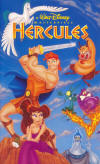 Hercules
(1997) This is the 43rd movie in our Disney Animated Feature
Marathon, and the first one I hadn’t seen yet. I wasn’t really
looking forward to it. I had been under the impression that it was
an attempt by the folks at Disney to be hip, and in my experience
Disney doesn’t do hip very well. Turns out I was wrong. Four years
before Shrek
worked hundreds of contemporary references into a fairy tale,
Hercules had done it already. This is a kinetic—without
being hyperkinetic—funny, wonderfully imagined and animated,
satirical take on Greek mythology that slips in dozens of references
to other movies and lampoons our culture of celebrity and
exploitation. If it fails to get you too emotionally involved,
that’s okay, too. This one is purely for fun, though the story about
growing up and proving yourself isn’t really all that bad. It is
narrated by a real Greek chorus of five ladies who come to life from
Grecian urns and sing gospel and R&B (okay, they stole that from
Little Shop of
Horrors, but it’s done very well), and even pokes fun at
earlier Disney movies, because it starts off with
Charlton
Heston solemnly intoning the introduction, a la
Beauty and the Beast,
before the spirited ladies shove him aside and start to boogie.
(It’s funny how anachronistic music works so well here and so
disastrously with Roger Miller’s
country tunes in Robin Hood.)
Danny DeVito
is very good as a satyr, but just as
Robin Williams owned
Aladdin,
James Woods
totally steals the show as Hades, a guy whose head is always on fire
and who talks like a demented used car salesman. Like Williams, he
improvised a lot of dialogue. It’s really a great performance, and a
great animation.
Hercules
(1997) This is the 43rd movie in our Disney Animated Feature
Marathon, and the first one I hadn’t seen yet. I wasn’t really
looking forward to it. I had been under the impression that it was
an attempt by the folks at Disney to be hip, and in my experience
Disney doesn’t do hip very well. Turns out I was wrong. Four years
before Shrek
worked hundreds of contemporary references into a fairy tale,
Hercules had done it already. This is a kinetic—without
being hyperkinetic—funny, wonderfully imagined and animated,
satirical take on Greek mythology that slips in dozens of references
to other movies and lampoons our culture of celebrity and
exploitation. If it fails to get you too emotionally involved,
that’s okay, too. This one is purely for fun, though the story about
growing up and proving yourself isn’t really all that bad. It is
narrated by a real Greek chorus of five ladies who come to life from
Grecian urns and sing gospel and R&B (okay, they stole that from
Little Shop of
Horrors, but it’s done very well), and even pokes fun at
earlier Disney movies, because it starts off with
Charlton
Heston solemnly intoning the introduction, a la
Beauty and the Beast,
before the spirited ladies shove him aside and start to boogie.
(It’s funny how anachronistic music works so well here and so
disastrously with Roger Miller’s
country tunes in Robin Hood.)
Danny DeVito
is very good as a satyr, but just as
Robin Williams owned
Aladdin,
James Woods
totally steals the show as Hades, a guy whose head is always on fire
and who talks like a demented used car salesman. Like Williams, he
improvised a lot of dialogue. It’s really a great performance, and a
great animation.
Many of the deities of Greek mythology are present, such as the three-headed dog, Cerberus, and a little of it is even accurate. In myth Heracles had to perform twelve labors, and we see a few of these. About half of them involve standard heroic things such as killing or capturing creatures like the Nemean lion or the Hydra, which grew two new heads for every one you cut off. But some labors were more prosaic, and the one that I’ve always thought was interesting was cleaning out the Augean stables. When I heard of it, I thought, Are you serious? Yep. The stables were the home to divine cattle that never got sick, and they pooped like crazy. They hadn’t been mucked out in 30 years. Oh, and he had to do it in one day. That was real heroism. Wouldn’t that have made a nice scene here? No? I guess not. Let’s not even get into all the people he killed, including the two children borne to him by the love interest of this film, Megara, his four marriages, or his bisexuality …
Cranks who hated it: The Greeks. Reason: Foreigners distorting our history and culture. IMDb.com
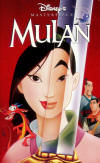 Mulan
(1998) This is a rather somber film, that takes its
time—unlike so many animations today—to tell a strong story in a
beautiful way. It’s the old, old gag of a girl passing herself off
as a boy. This being China, it is to preserve the family honor by
serving in the Army, defending against the Huns, who cross the Great
Wall in the opening scenes. Mulan is not quite a tomboy, but isn’t
very good at the subservient, voiceless demeanor demanded of an
eligible bride. She wears her disabled father’s armor and manages to
fool everyone for a long time, long enough to learn how to fight,
and to be the brains of the outfit, eventually routing all but a
small number of the Huns. Then she is discovered, and her captain
despises her and she has to prove herself all over again.
Mulan
(1998) This is a rather somber film, that takes its
time—unlike so many animations today—to tell a strong story in a
beautiful way. It’s the old, old gag of a girl passing herself off
as a boy. This being China, it is to preserve the family honor by
serving in the Army, defending against the Huns, who cross the Great
Wall in the opening scenes. Mulan is not quite a tomboy, but isn’t
very good at the subservient, voiceless demeanor demanded of an
eligible bride. She wears her disabled father’s armor and manages to
fool everyone for a long time, long enough to learn how to fight,
and to be the brains of the outfit, eventually routing all but a
small number of the Huns. Then she is discovered, and her captain
despises her and she has to prove herself all over again.
It is a very feminist story, showing a strong woman and the sexist odds she is up against. Mulan is quite agile and strong—not quite ridiculously agile like Crouching Tiger, Hidden Dragon, but quick on her feet and able to swing about like Tarzan. I think it’s significant that, though she is not the daughter of a king and therefore not a real princess, she had been included in the line of Disney Princesses anyway because she’s so popular, and I don’t think it’s just with Asian girls. She is really the physically and mentally strongest female main character I can think of in a Disney feature, and girls seem to like that … when they’re not dressing up as wimpy Snow White or Cinderella. (Once again, Disney folks, re-think Esmeralda from The Hunchback of Notre Dame. She could be the daughter of the King of the Gypsies, couldn’t she? You never said she wasn’t, and there is such a person.)
The look of the film is captivating, hinting at those classical Chinese paper screens with a few brush strokes of black and red without being slavishly imitative of them. During one point in a musical number the characters actually do transform into moving pictograms and the effect is enchanting. CGI is advancing once more here; there is a scene with thousands of mounted Huns coming over a rise and charging down a snow-covered hill that would be easy today, but was stunning at the time.
The amusing sidekicks here (a cliché that still seems to work almost all the time) is a “lucky” cricket and a very small dragon named Mushu, voiced by Eddie Murphy. He’s not quite in the league of James Woods and Robin Williams, but he’s very good. Many of the other characters, most importantly Ming-Na as Mulan, are voiced by Chinese actors … or Japanese.
Cranks who hated it: I would have expected somebody to object to not having an all-Chinese cast, but I never heard about it. IMDb.com
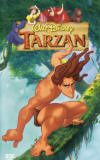 Tarzan
(1999) The 900-pound gorilla (so to speak) of
Computer Generated Imagery really begins to make it self felt in
this feature. CGI had been used by Disney as far back as
The Great Mouse Detective
in 1986, and in scenes here and there in all the movies after that.
But this one relies on a program called Deep Canvas for most of its
backgrounds, which are three dimensional virtual spaces and allow
the hand-drawn characters to move in any direction through the
created universe.
Toy Story,
the first totally-CGI animated feature, was already four years old.
It was quite an achievement, but all the surfaces in that movie were
hard-edged. Deep Canvas allowed for a more organic feel to the
environments, and it’s quite impressive to see.
Tarzan
(1999) The 900-pound gorilla (so to speak) of
Computer Generated Imagery really begins to make it self felt in
this feature. CGI had been used by Disney as far back as
The Great Mouse Detective
in 1986, and in scenes here and there in all the movies after that.
But this one relies on a program called Deep Canvas for most of its
backgrounds, which are three dimensional virtual spaces and allow
the hand-drawn characters to move in any direction through the
created universe.
Toy Story,
the first totally-CGI animated feature, was already four years old.
It was quite an achievement, but all the surfaces in that movie were
hard-edged. Deep Canvas allowed for a more organic feel to the
environments, and it’s quite impressive to see.
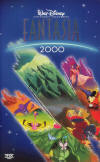 Fantasia
2000
(1999) Walt intended Fantasia
to be an ongoing project. Take a segment out and replace it with
something else, do that with three or four segments and put it back
into theaters. Since Fantasia was not a smashing
success, it never happened, and I think that’s probably a good
thing. I don’t think many people would pay to go to a movie they’d
already seen half of, not back then when movies didn’t get much
repeat business. But now in the age of the DVD I think it might
work. Not the replacement idea, a whole new movie composed of shorts
interpreting classical music. Of course, they say the DVD era is
ending, so maybe they should just make a short for every feature
they release, like Pixar does.
Fantasia
2000
(1999) Walt intended Fantasia
to be an ongoing project. Take a segment out and replace it with
something else, do that with three or four segments and put it back
into theaters. Since Fantasia was not a smashing
success, it never happened, and I think that’s probably a good
thing. I don’t think many people would pay to go to a movie they’d
already seen half of, not back then when movies didn’t get much
repeat business. But now in the age of the DVD I think it might
work. Not the replacement idea, a whole new movie composed of shorts
interpreting classical music. Of course, they say the DVD era is
ending, so maybe they should just make a short for every feature
they release, like Pixar does.
This was the first Disney movie to be released in IMAX format. I didn’t see it that way; in 2000 there were not as many IMAX theaters as there are now. But it was good on a regular screen, too. Not as good as the original, I have to say. It’s also very short, only 75 minutes compared to 125 minutes for Fantasia … and at least 5 minutes of that is the endless end credits, which they didn’t have in 1940. I’ve wondered if IMAX was one reason to keep it short. As I recall, most IMAX films were around an hour or less, because the film itself was so massive there wasn’t room to store it all in the giant projection room. Obviously they’ve solved that problem, running films like Avatar. There were eight segments in this one, each introduced by a different person, from Quincy Jones to Bette Midler to Penn & Teller. Here’s the list:
Symphony No. 5 in C minor-I. Allegro con brio. Ludwig van Beethoven. This is analogous to the Bach Toccata and Fugue from the original movie, using abstract shapes, though overall it resembles a windstorm. Like many of these shorts, it showcases the ability to animate thousands and thousands of elements, far more than could be hand-animated. It’s interesting to watch, but a bit dated now.
The Pines of Rome. Ottorino Respighi. My liking of these pieces is influenced by how much I like the music, and I’ve never cared for this one. To make matters worse, it involves humpback whales that somehow gain the ability to fly. The whales are wonderfully done, but the whole thing looks very silly. I wish they’d kept them underwater.
Rhapsody in Blue. George Gershwin. I’ve always contended that artistry is much more important that technical wizardry, and this, the best of the lot, proves my point. The animation is simple, based on the style of caricaturist Al Hirschfeld, which perfectly fits the music. It doesn’t hurt that Rhapsody in Blue is on my Top Ten list of best music of all time. When I’m listening to it, it’s #1.
Piano Concerto No. 2 in F Major, Allegro. Dmitri Shostakovich. The story is based on Hans Christian Andersen's “The Steadfast Tin Soldier.” I don’t know either the story or the music, and I was minimally impressed.
The Carnival of the Animals, Finale. Camille Saint-Saëns. A total trifle, not much more than a minute long. A flamingo finds a yo-yo and makes a lot of trouble. It doesn’t compare well with the dancing hippos in the first one.
The Sorcerer's Apprentice. Paul Dukas. A segment from the original Fantasia featuring Mickey Mouse. You can’t go wrong with this one, an all-time classic.
Pomp and Circumstance - Marches 1, 2, 3 and 4. Edward Elgar. There’s a lot more to Elgar’s P&C than the familiar graduation tune (which I swear I must have played 5,000 times while three classes at NHS got their diplomas), and a lot of themes are mashed together here. Donald and Daisy Duck are Noah’s assistants, loading animals into the ark. Again, Mickey and the sorcerer were much better
Firebird Suite, 1919 Version. Igor Stravinsky. My second favorite. The eruption of Mount St. Helens is portrayed as the attack of a monster creature of fire that wipes out everything, until a green sprite is revived by an elk and makes the ground erupt with life. Very pretty, very dramatic, very Stravinsky. IMDb.com
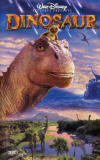 Dinosaur
(2000) How quickly CGI has evolved. Remember
Tron,
way, way, way, way back in 1982? It’s incredibly primitive, cost
$17,000,000 to make (big money in 1982), and was very, very hard to
do, harder and more labor-intensive than hand-drawn animation. The
computer wasn’t capable of showing motion, so the coordinates for
each frame had to be entered by hand. And there’s less CGI in it
than you might think: only about 20 minutes.
Dinosaur
(2000) How quickly CGI has evolved. Remember
Tron,
way, way, way, way back in 1982? It’s incredibly primitive, cost
$17,000,000 to make (big money in 1982), and was very, very hard to
do, harder and more labor-intensive than hand-drawn animation. The
computer wasn’t capable of showing motion, so the coordinates for
each frame had to be entered by hand. And there’s less CGI in it
than you might think: only about 20 minutes.
Now look at Dinosaur. Technically it isn’t anything special by today’s standards—ten years is a geological age in computer graphics!—but way, way back in 2000 it was pretty stunning. We had already seen pretty good dinosaurs in Jurassic Park, but not nearly so many of them. Dinos are in every frame of this movie, and they look absolutely real … well, except for the business of them talking … They also used an innovative technique of putting the CGI dinosaurs into real-world backgrounds, which I’m sure saved a lot of money on computer time and actually makes the picture look even better. And the scenes where the giant fireballs are coming down were astonishing and actually scary.
But it’s a rather grim story. Not a lotta laughs, though the little lemur/monkeys (with the best CGI hair ever done up to that point) try hard. It’s a survival-of-the-fittest vs. let’s-all-help-each-other dynamic, and frankly, it just didn’t go down well with me. It’s all so real (again, except for the talking, which I agree with Roger Ebert was a mistake) that the idea of these various plant-eating species traveling together like pilgrims to Canterbury just never resonated with me. Of course, we know almost nothing about dinosaur behavior—it’s only recently we determined that some of them at least guarded their eggs, like alligators do—so I suppose anything’s possible, but it’s still a weak story.
And I must stand up again for the predators of the world. Why don’t they talk? The gangs of velociraptors never speak, and neither do the T. rexes. Are they dumb? … Er, I mean stupid? This is unfair. Why couldn’t a T. rex say something like “You look delicious,” or “Yum, yum, I’m gonna eat you, because that’s my role in the great ecological food chain, and besides, I’m a Darwinian agent of natural selection; I’m making your herd stronger by killing the old, slow, and weak. So hakuna matata, you poor schmuck.” Nobody ever talks about that. Carnivores get a bad rap in cartoons. Even when they’re the hero, like The Lion King, what does Simba eat? Maggots and worms, while Scar dines on warm, succulent haunch of zebra. IMDb.com
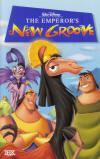 The
Emperor’s New Groove
(2000) This movie has less of the Disney look and feel of any of the
47 features we’ve watched so far. Somebody said it seemed more like
a Warner Brother Looney Tune than a Disney movie. That’s not all
bad, of course, and there is a lot of sly humor here, but mostly
it’s all knockabout action and slapstick gags. I understand it was
what is known as a “troubled” production, and several times came
within an inch of being cancelled. Originally, it was going to be a
Prince and the Pauper story, with the Emperor changing
places with a peasant. That was eventually seen as not very
original; how many P&P variations have you seen?
Dozens. So they started over from square one, and six years later,
this is the result.
The
Emperor’s New Groove
(2000) This movie has less of the Disney look and feel of any of the
47 features we’ve watched so far. Somebody said it seemed more like
a Warner Brother Looney Tune than a Disney movie. That’s not all
bad, of course, and there is a lot of sly humor here, but mostly
it’s all knockabout action and slapstick gags. I understand it was
what is known as a “troubled” production, and several times came
within an inch of being cancelled. Originally, it was going to be a
Prince and the Pauper story, with the Emperor changing
places with a peasant. That was eventually seen as not very
original; how many P&P variations have you seen?
Dozens. So they started over from square one, and six years later,
this is the result.
It looks damn good, especially the gigantic temples and jungles and steep canyons where all the action takes place. The best thing about it is the two villains, and isn’t that so often the case? The good guys are constrained by moral behavior, but the bad guys get to do anything damn thing they want, and have a hell of a lot of fun doing it. In this case it is Eartha Kitt as Yzma, the Emperor’s advisor who, when she is fired, plots to kill him but only succeeds in turning him into a llama. She is wonderful, a Disney bad girl so skinny she makes my darling Cruella look like the circus fat lady. She is ineptly abetted by one Kronk, a man so stupid you’d need to frequently remind him to breathe. But they have made him endearing, in that he’s not really a bad guy, he’s more of a clueless henchman. And when did you ever see a smart henchman? It’s practically in the job description: Wanted, henchman. Must have IQ equal to or less than his shoe size. All he really wants to do is cook, and can be instantly distracted by children playing games, which he enthusiastically joins.
Sorry to say that the worst thing about it, from my point of view, is David Spade as the Emperor. I’m not a fan of Spade, whose snarky sarcasm works for me for only a few minutes at a time, but the film is 95 minutes long and he’s in most scenes. He recycles all his SNL bits, including the stupid “buh-bye” routine. Yeah, I know he’s supposed to be Mr. Ultra-cool, but he’s a one-joke comedian, funny the first time you see him, tiresome after that. IMDb.com
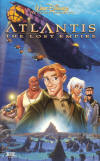 Atlantis:
The Lost Empire
(2001) A pretty experimental film for Disney. And, though the movie
has its charms, I’d have to say it’s a failed experiment. It’s an
action-adventure on the model of the
Indiana Jones
movies, though there’s no Indy character. It’s also said to be
inspired by
20,000 Leagues Under the Sea, in that it starts off with
a 1914 super-submarine searching for lost Atlantis. There’s a motley
multi-ethnic crew aboard, our hero being a nerdy young scientist (Michael
J. Fox), and the commander a soldier voiced by
James Garner.
The style is a mix of
anime and American comic book. The opening scenes of the
destruction of Atlantis are in fact so anime-looking that the
artists were accused of plagiarizing from some Japanese sources.
There are some visual attractions here, but basically I wasn’t too
involved.
Atlantis:
The Lost Empire
(2001) A pretty experimental film for Disney. And, though the movie
has its charms, I’d have to say it’s a failed experiment. It’s an
action-adventure on the model of the
Indiana Jones
movies, though there’s no Indy character. It’s also said to be
inspired by
20,000 Leagues Under the Sea, in that it starts off with
a 1914 super-submarine searching for lost Atlantis. There’s a motley
multi-ethnic crew aboard, our hero being a nerdy young scientist (Michael
J. Fox), and the commander a soldier voiced by
James Garner.
The style is a mix of
anime and American comic book. The opening scenes of the
destruction of Atlantis are in fact so anime-looking that the
artists were accused of plagiarizing from some Japanese sources.
There are some visual attractions here, but basically I wasn’t too
involved.
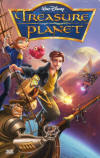 Treasure
Planet
(2002) You really just never know. I wasn’t looking forward to this,
the first of four early 21st century Disney features that I’ve never
seen. The reviews were not very good, it was maybe the biggest
box-office bomb for Disney since Fantasia,
and the whole concept of retelling Stevenson’s
Treasure
Island with sailing ships in outer space seemed more
than a little loony. And in the end, I liked it a lot. So what went
wrong? Why such a flop?
Treasure
Planet
(2002) You really just never know. I wasn’t looking forward to this,
the first of four early 21st century Disney features that I’ve never
seen. The reviews were not very good, it was maybe the biggest
box-office bomb for Disney since Fantasia,
and the whole concept of retelling Stevenson’s
Treasure
Island with sailing ships in outer space seemed more
than a little loony. And in the end, I liked it a lot. So what went
wrong? Why such a flop?
Maybe it was the sailing ships in space business, after all. And oddly enough, though I tend to prefer hard science stories, there is really nothing here conceptually that is as ridiculous as it sounds. There really are things called solar sails, and while of course they would look nothing like what is shown here—they would have to be much larger, would accelerate very slowly, and would be unlikely to be mounted on what look to be wooden ships—they are possible. And even the idea of them moving though a space that is breathable is not beyond the realm of reason. A star-sized Dyson sphere, or better yet a galactic-sized one, could have an atmosphere. True, you couldn’t movie through it very fast without encountering all the friction problems of hypersonic flight, but why quibble? There would be very little gravity, but we see them turn on the artificial gravity, and AG has been a staple of hard SF forever.
And, of course, if none of those explanations satisfy, there is the old stand-by of an alternate universe where different physical laws apply. Maybe we should just stick with that one.
It’s eight years old now, but the CGI holds up well even compared to the stuff we’re seeing currently. There is one awesome shot where we zoom in on a crescent moon, and as we get closer we realize it is a gigantic crescent-shaped spaceport bustling with activity. Cool! There are hundreds of well-imagined aliens, including one who speaks by farting out of about a dozen orifices. (“I speak Flatulan,” one character says to Jim.) Instead of having just a peg leg, John Silver has an artificial arm, too, a cyborg thing that sprouts any tool he needs. It’s true that Jim Hawkins is something of a stiff, but that’s in the nature of these stories, where the bad guys and the comic relief are always more interesting. Silver is a great character, as is Martin Short as a malfunctioning robot. The comic sidekick is a little pink blob called Morph, who can turn into anything, and takes the place of Silver’s parrot. Also great is Emma Thompson as the heroic, catlike captain of the treasure ship. So, again, what’s not to like? IMDb.com
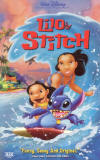 Lilo
and Stitch
(2002) One of the few Disney features to be set in the present day.
It’s also in an interesting and exotic setting: Hawaii. (Or, I
notice that these days we’re supposed to spell it Hawai’i. Well, why
not? I have to admire a language with only seven consonants, which
includes words like Humuhumunukunukuāpuaʻa.) Teenager Nani and her
younger sister Lilo have been recently orphaned, and a social worker
(a hulking, scary man named Cobra Bubbles, voiced coldly but
menacingly by
Ving Rhames) is threatening to take Lilo away. Meanwhile, in a
far distant corner of the universe, the Galactic Council has
confiscated a monster named 626, about the size of a Pekinese but
even uglier and more vicious, and nearly indestructible to boot.
They exile the monster, but he escapes to Earth. They are going to
destroy the planet but an agent, Wendy Pleakley, steps forward and
says you can’t do that, it’s the home of the endangered mosquito. So
he and the monster’s creator, four-eyed Dr. Jumba Jookiba (who
speaks with a
Boris Badenov accent), are sent to retrieve 626, who has been
mistaken for a dog. Lilo adopts 626 and names him Stitch and
eventually shows him the error of his genetically-programmed ways;
his purpose is basically to destroy cities, like a miniscule
Godzilla.
Lilo
and Stitch
(2002) One of the few Disney features to be set in the present day.
It’s also in an interesting and exotic setting: Hawaii. (Or, I
notice that these days we’re supposed to spell it Hawai’i. Well, why
not? I have to admire a language with only seven consonants, which
includes words like Humuhumunukunukuāpuaʻa.) Teenager Nani and her
younger sister Lilo have been recently orphaned, and a social worker
(a hulking, scary man named Cobra Bubbles, voiced coldly but
menacingly by
Ving Rhames) is threatening to take Lilo away. Meanwhile, in a
far distant corner of the universe, the Galactic Council has
confiscated a monster named 626, about the size of a Pekinese but
even uglier and more vicious, and nearly indestructible to boot.
They exile the monster, but he escapes to Earth. They are going to
destroy the planet but an agent, Wendy Pleakley, steps forward and
says you can’t do that, it’s the home of the endangered mosquito. So
he and the monster’s creator, four-eyed Dr. Jumba Jookiba (who
speaks with a
Boris Badenov accent), are sent to retrieve 626, who has been
mistaken for a dog. Lilo adopts 626 and names him Stitch and
eventually shows him the error of his genetically-programmed ways;
his purpose is basically to destroy cities, like a miniscule
Godzilla.
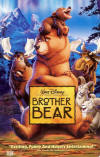 Brother
Bear
(2003) This is a gorgeous film to look at, but the story didn’t
really get to me that much. It’s a simple tale, and rings true as an
Indian legend, though I don’t know if it is one. It involves a boy
wanting to become a man, but rejecting his assigned totem of the
bear. His older brother is killed by a bear, who it turns out was
just guarding her cub. The younger brother vows revenges, kills the
bear, which is in violation of his karma, or something. The Great
Spirits turn him into a bear so he can see what it’s like from the
other side. Naturally he befriends a cub who turns out to be the
orphan of the dead bear mother. Eventually he learns tolerance, and
that being a bear ain’t so bad. He ends up staying ursine, and
everybody lives happily ever after. As I said, the look of the film
is ravishing. They also employ a trick of morphing from standard
screen to widescreen when the boy is transformed, and using a whole
new, brilliant color palette that reminded me of
Maxfield
Parrish. It is a mix of CGI for the effects and hand-drawn for
the characters, a technique that was soon to vanish until
The Princess and the Frog.
It features Rick
Moranis and
Dave
Thomas reprising their schtick as bumbling Canadian hosers Bob
and Doug McKenzie, from their SCTV show “The Great White North.”
Here they are mooses, eh? Meeses? Meese?
IMDb.com
Brother
Bear
(2003) This is a gorgeous film to look at, but the story didn’t
really get to me that much. It’s a simple tale, and rings true as an
Indian legend, though I don’t know if it is one. It involves a boy
wanting to become a man, but rejecting his assigned totem of the
bear. His older brother is killed by a bear, who it turns out was
just guarding her cub. The younger brother vows revenges, kills the
bear, which is in violation of his karma, or something. The Great
Spirits turn him into a bear so he can see what it’s like from the
other side. Naturally he befriends a cub who turns out to be the
orphan of the dead bear mother. Eventually he learns tolerance, and
that being a bear ain’t so bad. He ends up staying ursine, and
everybody lives happily ever after. As I said, the look of the film
is ravishing. They also employ a trick of morphing from standard
screen to widescreen when the boy is transformed, and using a whole
new, brilliant color palette that reminded me of
Maxfield
Parrish. It is a mix of CGI for the effects and hand-drawn for
the characters, a technique that was soon to vanish until
The Princess and the Frog.
It features Rick
Moranis and
Dave
Thomas reprising their schtick as bumbling Canadian hosers Bob
and Doug McKenzie, from their SCTV show “The Great White North.”
Here they are mooses, eh? Meeses? Meese?
IMDb.com
 Finding
Nemo
(2003) For a few years this was the highest-grossing
animated film of all time. It was recently surpassed by Toy
Story 3 and one of the Shrek films, but that
may be just ticket-price inflation. Not that box office performance
really has to have all that much to do with quality; some real
stinkers have made hundreds of millions and some masterpieces have
tanked at the B.O. Not that it matters. It’s just gratifying,
because this picture really deserved its blockbuster numbers, as
have all Pixar films to date. Something else that is probably
neither here nor there is that if it had been made by Disney or
Dreamworks, there surely would have been a Finding Nemo 2
by now. But it was made by the geniuses at Pixar, and so far there
have been no plans for a sequel. That may not last—Pixar’s next two
films are going to be Cars 2 and Monsters, Inc.
2, and we can only hope that though they have succumbed to
sequel mania, the results will be more like the Toy Story
franchise and less like the Shrek sequels. My vote:
Don’t do it, Pixar guys. This is a splendid story, and it’s
complete. Don’t do a direct-to-video rip-off like Disney does,
either. Let it stay clean, glorious, and on its own, like
To Kill a
Mockingbird.
Finding
Nemo
(2003) For a few years this was the highest-grossing
animated film of all time. It was recently surpassed by Toy
Story 3 and one of the Shrek films, but that
may be just ticket-price inflation. Not that box office performance
really has to have all that much to do with quality; some real
stinkers have made hundreds of millions and some masterpieces have
tanked at the B.O. Not that it matters. It’s just gratifying,
because this picture really deserved its blockbuster numbers, as
have all Pixar films to date. Something else that is probably
neither here nor there is that if it had been made by Disney or
Dreamworks, there surely would have been a Finding Nemo 2
by now. But it was made by the geniuses at Pixar, and so far there
have been no plans for a sequel. That may not last—Pixar’s next two
films are going to be Cars 2 and Monsters, Inc.
2, and we can only hope that though they have succumbed to
sequel mania, the results will be more like the Toy Story
franchise and less like the Shrek sequels. My vote:
Don’t do it, Pixar guys. This is a splendid story, and it’s
complete. Don’t do a direct-to-video rip-off like Disney does,
either. Let it stay clean, glorious, and on its own, like
To Kill a
Mockingbird.
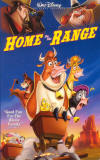 Home
on the Range
(2004) Sometimes I wonder, “What were they thinking?” There’s not a
lot on offer here in this very un-Disney feature. Three cows (Roseanne
Barr, Judi
Dench—Judi Dench?!—and
Jennifer Tilly)
set out to find big bad cattle rustler Alameda Slim to bring him to
justice and save the ranch. That’s it as far as story goes. The
visual style owes more to
Hanna-Barbera
stuff like Yogi Bear than to Disney, with Monument Valley
backgrounds stolen from the
Warner Brothers
Road Runner cartoons. There’s a little of the style of “Pecos
Bill” and a little of the classic little short “Pigs
is Pigs.” Everything is angular and simplified. Which
worked for a short, but gets a little tedious here. The other
barnyard critters are rather boring, taken right off the shelf
without much to make them interesting. The human hero, a tall,
whispering
Clint Eastwood type, is funny for a little while. The best thing
is probably Alameda Slim (Randy
Quaid), who is such a ferocious yodeler that he can hypnotize
cattle and cause them to follow him, a sort of Pied Piper of
livestock. There are some visual effects during his big number that
are pretty good, very colorful. But mostly this is a knockabout
slapstick featurette drawn out to barely feature length (75 minutes
including long credits). It was a major box office
bomb and probably deserved to be. Its failure shut down the Orlando
animation studio and Disney pulled back to Burbank and settled in
for a long run of all-CGI features for a while. Which, if you want
my opinion, is not really where they shine, but may be the
inevitable wave of the future.
IMDb.com
Home
on the Range
(2004) Sometimes I wonder, “What were they thinking?” There’s not a
lot on offer here in this very un-Disney feature. Three cows (Roseanne
Barr, Judi
Dench—Judi Dench?!—and
Jennifer Tilly)
set out to find big bad cattle rustler Alameda Slim to bring him to
justice and save the ranch. That’s it as far as story goes. The
visual style owes more to
Hanna-Barbera
stuff like Yogi Bear than to Disney, with Monument Valley
backgrounds stolen from the
Warner Brothers
Road Runner cartoons. There’s a little of the style of “Pecos
Bill” and a little of the classic little short “Pigs
is Pigs.” Everything is angular and simplified. Which
worked for a short, but gets a little tedious here. The other
barnyard critters are rather boring, taken right off the shelf
without much to make them interesting. The human hero, a tall,
whispering
Clint Eastwood type, is funny for a little while. The best thing
is probably Alameda Slim (Randy
Quaid), who is such a ferocious yodeler that he can hypnotize
cattle and cause them to follow him, a sort of Pied Piper of
livestock. There are some visual effects during his big number that
are pretty good, very colorful. But mostly this is a knockabout
slapstick featurette drawn out to barely feature length (75 minutes
including long credits). It was a major box office
bomb and probably deserved to be. Its failure shut down the Orlando
animation studio and Disney pulled back to Burbank and settled in
for a long run of all-CGI features for a while. Which, if you want
my opinion, is not really where they shine, but may be the
inevitable wave of the future.
IMDb.com
 The Incredibles
(2004)
Everything I expected it to be, and even a bit more. One of the more
adult-themed feature-length animations I’ve ever seen, except maybe
The
Triplets of Belleville.
The animation is everything you’ve come to expect, and the story is even
better than
Finding Nemo, in my opinion. Of
course, that’s from an older viewer. It has more to do with family/work
conflicts than with actual "super-heroes." Also, it is scathing in its
view of how anybody who is “special” is made to pay, how individuality
is so often weeded out and crushed. And the very, very sad fact that no
good deed will go unpunished if you let lawyers take over your society.
The music was reminiscent of the
John Barry and
Henry Mancini
scores of the '60s and '70s. One other thing worth noting is that during
the closing credits they used what looked like computer-era “pencil
tests” behind the endless crawl of names: just simple shapes and primary
colors of action we’d already seen.
IMDb.com
The Incredibles
(2004)
Everything I expected it to be, and even a bit more. One of the more
adult-themed feature-length animations I’ve ever seen, except maybe
The
Triplets of Belleville.
The animation is everything you’ve come to expect, and the story is even
better than
Finding Nemo, in my opinion. Of
course, that’s from an older viewer. It has more to do with family/work
conflicts than with actual "super-heroes." Also, it is scathing in its
view of how anybody who is “special” is made to pay, how individuality
is so often weeded out and crushed. And the very, very sad fact that no
good deed will go unpunished if you let lawyers take over your society.
The music was reminiscent of the
John Barry and
Henry Mancini
scores of the '60s and '70s. One other thing worth noting is that during
the closing credits they used what looked like computer-era “pencil
tests” behind the endless crawl of names: just simple shapes and primary
colors of action we’d already seen.
IMDb.com
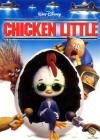 Chicken
Little
(2005) Here is the very last Disney animated feature I hadn’t seen
yet. It is also the first completely CGI feature, and the first one
to have no VHS release. I think it was the first one to come in a 3D
version, too, though I’m not sure about that. And here we have what
seems to me a prime example of how a concept can be blown up all out
of proportion. We begin with the old tale of “The sky is falling!”
and end up with a huge invasion of the planet by aliens bent on
destroying us. Turns out they’re only trying to rescue one of their
children. Chicken Little meets The War of the Worlds and the
Son of E.T. The alien machines even look like the spidery
robots in Spielberg’s remake. The movie is designed well, and it has
a certain amount of self-aware wit, and some good laughs and amusing
sequences. In a classroom teaching Sheep 101, every word translates
as baa. In the Little home all the windows are covered
with chicken wire. But the story is pretty weak.
IMDb.com
Chicken
Little
(2005) Here is the very last Disney animated feature I hadn’t seen
yet. It is also the first completely CGI feature, and the first one
to have no VHS release. I think it was the first one to come in a 3D
version, too, though I’m not sure about that. And here we have what
seems to me a prime example of how a concept can be blown up all out
of proportion. We begin with the old tale of “The sky is falling!”
and end up with a huge invasion of the planet by aliens bent on
destroying us. Turns out they’re only trying to rescue one of their
children. Chicken Little meets The War of the Worlds and the
Son of E.T. The alien machines even look like the spidery
robots in Spielberg’s remake. The movie is designed well, and it has
a certain amount of self-aware wit, and some good laughs and amusing
sequences. In a classroom teaching Sheep 101, every word translates
as baa. In the Little home all the windows are covered
with chicken wire. But the story is pretty weak.
IMDb.com
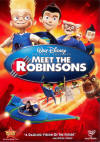 Meet
the Robinsons
(2006) Traditionally in Hollywood, if an action movie has a
weakness, it is in the third act, when everything falls apart in a
flurry of violence and illogic. Here we have a movie which has a
really bad second act, and the reason is simple: Too
many Robinsons. The movie was adapted from a book called
A
Day With Wilbur Robinson. If the book had any fans (I
have no idea) they must have been howling, because it was apparently
about a boy who takes a trip into the country and meets the Robinson
family. Each one he meets is weirder than the last one. The plot
revolves around looking for Grandpa’s false teeth. The writers have
taken this and wrapped a complicated plot around it involving time
travel, strange inventions, and an orphan looking for his mother.
And, oddly, this is the part that works, the set-up
and the resolution. In between we meet the weird Robinsons and there
just isn’t enough time to get to know any of them. It’s like walking
quickly past a carnival sideshow. Here’s the fat lady, here’s the
contortionist, here’s the … come on, move along now, we ain’t got
all day if we’re going to see the fire-eater. My feeling was that if
they’d cut the number of family members in half it would have worked
a lot better. Characters would have had time to establish themselves
in my mind.
Meet
the Robinsons
(2006) Traditionally in Hollywood, if an action movie has a
weakness, it is in the third act, when everything falls apart in a
flurry of violence and illogic. Here we have a movie which has a
really bad second act, and the reason is simple: Too
many Robinsons. The movie was adapted from a book called
A
Day With Wilbur Robinson. If the book had any fans (I
have no idea) they must have been howling, because it was apparently
about a boy who takes a trip into the country and meets the Robinson
family. Each one he meets is weirder than the last one. The plot
revolves around looking for Grandpa’s false teeth. The writers have
taken this and wrapped a complicated plot around it involving time
travel, strange inventions, and an orphan looking for his mother.
And, oddly, this is the part that works, the set-up
and the resolution. In between we meet the weird Robinsons and there
just isn’t enough time to get to know any of them. It’s like walking
quickly past a carnival sideshow. Here’s the fat lady, here’s the
contortionist, here’s the … come on, move along now, we ain’t got
all day if we’re going to see the fire-eater. My feeling was that if
they’d cut the number of family members in half it would have worked
a lot better. Characters would have had time to establish themselves
in my mind.
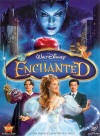 Enchanted
(2007) Every once in a while a movie manages to navigate the tricky
shoals of sentimentality without ever running aground on the reefs
of schmaltz. Amelie
was one. This is another. I have no problem with sentiment, if it is
laid on with humor and artistry. This movie pokes delightful fun at
almost every animated Disney movie ever made, while at the same time
being true to itself, and never getting snarky or condescending
about it. It’s one of those movies that exist only to make you grin
for two hours. What more could I ask of such a picture? If you can
watch the music/dance number in Central Park and not have a smile on
you face, I probably don’t want to know you. As for the “Whistle
While You Work” sequence, where all the creatures of the forest
help Snow White clean up the cottage … only it’s a New York
apartment, and the critters are rats, pigeons, and roaches … must be
seen to be believed! I loved it! In fact, I had only one complaint,
and that is we didn’t get to see enough of
Susan Sarandon
as the Wicked Witch. She was having such a great time in the role,
and she is so good … a little more of her would have
been nice. But that’s a small cavil. See this, and enjoy.
IMDb.com
Enchanted
(2007) Every once in a while a movie manages to navigate the tricky
shoals of sentimentality without ever running aground on the reefs
of schmaltz. Amelie
was one. This is another. I have no problem with sentiment, if it is
laid on with humor and artistry. This movie pokes delightful fun at
almost every animated Disney movie ever made, while at the same time
being true to itself, and never getting snarky or condescending
about it. It’s one of those movies that exist only to make you grin
for two hours. What more could I ask of such a picture? If you can
watch the music/dance number in Central Park and not have a smile on
you face, I probably don’t want to know you. As for the “Whistle
While You Work” sequence, where all the creatures of the forest
help Snow White clean up the cottage … only it’s a New York
apartment, and the critters are rats, pigeons, and roaches … must be
seen to be believed! I loved it! In fact, I had only one complaint,
and that is we didn’t get to see enough of
Susan Sarandon
as the Wicked Witch. She was having such a great time in the role,
and she is so good … a little more of her would have
been nice. But that’s a small cavil. See this, and enjoy.
IMDb.com
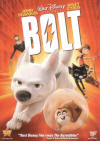 Bolt
(2008) And
so we come to the end of our chronological viewing of all Disney
feature animated movies (including those that have some
animation, like Enchanted and
Mary Poppins). (We watched
The Princess and the Frog
out of order.) Now we’ll have to wait until Thanksgiving—I’m writing
this on July 26—for Tangled. In the meantime we will
watch all the Pixar features except the Toy Story
trilogy, which I’ve already seen and reviewed. After that … who
knows? Maybe we’ll take a crack at some other animated features.
I’ve missed a few.
Bolt
(2008) And
so we come to the end of our chronological viewing of all Disney
feature animated movies (including those that have some
animation, like Enchanted and
Mary Poppins). (We watched
The Princess and the Frog
out of order.) Now we’ll have to wait until Thanksgiving—I’m writing
this on July 26—for Tangled. In the meantime we will
watch all the Pixar features except the Toy Story
trilogy, which I’ve already seen and reviewed. After that … who
knows? Maybe we’ll take a crack at some other animated features.
I’ve missed a few.
Every once in a great while a reviewer will take another look, reassess a movie, and reverse his previous opinion. That happened for a whole lot of critics with Bonnie and Clyde, which initially got terrible reviews, with 2001: A Space Odyssey, which very few people understood on first viewing, and with The Wild Bunch and Butch Cassidy and the Sundance Kid. I saw this movie new only two years ago and, while I’m not doing an about-face like so many did with those four movies—all of which are now acknowledged as classics—I feel like I should modify my original pan quite a bit. Casting about for a reason why it should strike me differently after only two years, I came up with two reasons, both of which I may have mentioned before in these pages. One, I think I really am getting more tolerant of vertiginous motion unless it’s wildly overdone, as in How to Train Your Dragon. Bolt is a long way from being one of the worst offenders here, though a little too much of it seems like gratuitous overkill. And second, watching a DVD on a HD television is not as disorienting, and at the same time seems more intimate, making it much easier for me to interact and sympathize with the characters.
For whatever reason, I enjoyed this second viewing way more than I did when seeing it on the big theater screen. (Not in 3D.) It still has its weaknesses. It’s funny, but a common weakness of films like this is that the main character isn’t as interesting as the supporting cast. Bolt is a movie-star super-dog who, somehow, has been prevented from knowing that he really has no superpowers. (We see some of how they cleverly accomplish this, and it’s fun, but come on, now …) However, you accept that premise because it’s fun to see him shipped cross-country and emerge in New York without a clue that his super-bark and super-speed and super-eyes don’t work anymore. (But we’ve seen it before, with Buzz Lightyear.) There he meets Mittens the street-wise cat and her retinue of semi-enslaved pigeons. The pigeons are great, and so is Mittens. They set out to cross the country and along the way pick up Rhino, the fearless, obese, hero-worshipping hamster who never loses faith in his hero, Bolt. All these characters are better than Bolt himself.
The look of the film is wonderful, crossing the country, arriving in Hollywood—which looks exactly like Hollywood really looks, and so does Las Vegas—and having adventures in the studios. Bolt’s super-weasel agent is funny, as are the Hollywood pigeons who instantly want to pitch an idea to Bolt (“Aliens!”), just like everyone in Hollywood really does. There’s a lot of heart in this movie. I feel like, with a little more work, it might have been a classic. IMDb.com
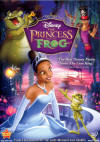 The
Princess and the Frog
(2009) Those of you
Faithful Readers who have been following the saga of our Saturday
night journey through the Walt Disney animated features all the way
from Snow White and
the Seven Dwarfs right through … well, this one, will
wonder why this one is being reviewed out of order. The simple
answer is that I just bought the DVD and wasn’t willing to wait
until some months down the line to see it. Tomorrow we will resume
our odyssey with Who Framed
Roger Rabbit.
The
Princess and the Frog
(2009) Those of you
Faithful Readers who have been following the saga of our Saturday
night journey through the Walt Disney animated features all the way
from Snow White and
the Seven Dwarfs right through … well, this one, will
wonder why this one is being reviewed out of order. The simple
answer is that I just bought the DVD and wasn’t willing to wait
until some months down the line to see it. Tomorrow we will resume
our odyssey with Who Framed
Roger Rabbit.
I am happy to report that just about everything about this movie is cause for rejoicing. It is a return to the best, without abandoning the truly wonderful things that can be done with the new technologies. It is the first hand-drawn feature since Home on the Range; that is, the characters are hand-animated, though the backgrounds and special visual effects were done with CGI. And that’s good. The New Orleans backgrounds really come alive. I was constantly recognizing places I’d been, from Jackson Square to the Garden District. And the magical voodoo effects and big production numbers totally dazzle. All this while retaining the special flavor of the old-timey 2D characters that will take you back to The Little Mermaid, Peter Pan, and Pinocchio. Disney’s previous three movies, Chicken Little, Meet the Robinsons, and Bolt, were all 3D CGI, and had more of a flavor of Pixar / Dreamworks than Disney. That is certainly not at all a bad thing—I’m on record as worshipping at the Pixar altar—but it’s a whole different style. And I’m delighted to hear that Disney has committed to doing a hand-drawn feature every two years or so. One hopes they can retain the hyperactive CGI audience while still serving the more story-oriented and even, shall we say, sentimental, 2D audience. Which is me.
But best of all, this is a strong return to the Broadway-type musical format that worked so well in The Little Mermaid, Beauty and the Beast, Aladdin, and others that finally took Disney animation from its moribund 1980s state right up to a first-ever Best Picture nomination. There has always been music in Disney features— and others were nothing but music: Fantasia, Fantasia 2000, Melody Time—but it was Alan Menken and Howard Ashman who introduced the Broadway sensibility, and they did it so well that several of those movies were retrofitted into actual Broadway shows, most notably The Lion King.
In a Broadway show, story is much more important than some people realize, and this one has a strong story. It’s something that Pixar has understood from the beginning: if you ain’t got story, all you’ve got is a lot of bright, kinetic energy. People will go see it—so long as it has 3D on the cover—but it won’t last. The Princess and the Frog didn’t do as well as some had hoped (a return of $270M on a $100M investment is seen as “disappointing” these days, and go figure that one out), but my feeling is that it will last a lot longer than, say, Kung Fu Panda or Over the Hedge. It’s anybody’s guess if Disney will be able to re-release it theatrically in 10 years, as they have traditionally done and thus made big money, eventually, even with their flops. Everything is in such a state of flux with 3D getting gigantic, and the new business of downloading, not to mention piracy. DVDs still seem so wonderfully new to me, but people are abandoning the format like a sinking ship. But whatever happens, I hope there is still a market for movies like this. IMDb.com
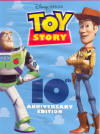 Toy Story
(1995) When I was a child my granddaddy managed the
Duke &
Ayres store in
Corsicana,
Texas. (Think
Woolworth’s, but smaller.) Among the many things he sold were
lots and lots of toys. As the spoiled grandson, I got to play with
them behind the counters, evaluate (my word for “play with”) them
for appeal, safety, and durability. A nasty job, but somebody had to
do it. If a toy happened to get broken, either in shipping or during
my rigorous product testing, Granddaddy could send it back or write
it off. It didn’t take me long to realize that a slightly
broken toy was just as much fun to play with as a mint-condition
toy. Result? I had lots of toys. Plus, every Christmas
we all got lots of toys that weren’t broken. We were
not a wealthy family, but I was probably the richest kid in town in
terms of toys, which at a certain age is the only thing that really
counts, isn’t it?
Toy Story
(1995) When I was a child my granddaddy managed the
Duke &
Ayres store in
Corsicana,
Texas. (Think
Woolworth’s, but smaller.) Among the many things he sold were
lots and lots of toys. As the spoiled grandson, I got to play with
them behind the counters, evaluate (my word for “play with”) them
for appeal, safety, and durability. A nasty job, but somebody had to
do it. If a toy happened to get broken, either in shipping or during
my rigorous product testing, Granddaddy could send it back or write
it off. It didn’t take me long to realize that a slightly
broken toy was just as much fun to play with as a mint-condition
toy. Result? I had lots of toys. Plus, every Christmas
we all got lots of toys that weren’t broken. We were
not a wealthy family, but I was probably the richest kid in town in
terms of toys, which at a certain age is the only thing that really
counts, isn’t it?
(I often wonder what happened to all those toys. Thrift shop or dumpster, most likely. I can’t even remember most of them, but one stands out. It was a tin rabbit motorcycle cop with a sidecar that would be filled with Easter candy every year. As it happens, I do know what happened to that one. My cousin Betsey got it. I was never quite clear on how or why my toy went to Betsey. I used to resent it, but I’ve grown up. I’ve forgiven her. No sense in making a big deal of it … except it was my rabbit, dammit!)
All through my childhood, surrounded with all those toys, it never occurred to me to wonder what happened when the lights went off, or when I wasn’t in the room. But it did to John Lasseter, Pete Doctor, Joss Whedon, and others at Pixar, who up to this point had only made some delightful CGI animated short subjects. This was their first feature, and the first feature to be entirely computer animated, and they arrived on the scene in style with this wonderful movie. Seeing it now, 15 years later, it still dazzles, so try to remember how astonishing it all was in 1995 if you’re old enough to do that. The attention to detail is simply amazing. Look at the first shot from Buzz Lightyear’s POV, and see his distorted face reflected in his plastic helmet. The action is fun and nearly non-stop, without ever being disorienting. It’s a movie filled with witty little touches. (Don Rickles as Mr. Potato Head delivers his trademark line “What are you looking at, you hockey puck?” to a hockey puck.) But as always with Pixar, it’s the story that makes it all work. The idea is fun all by itself, but the characterizations make it happen. Woody the pull-toy cowboy is a good guy, but he’s prone to jealousy when Buzz threatens the only relationship that gives his life meaning, with his owner. Buzz, who thinks he’s a genuine interstellar hero, is crushed to find that he’s just a toy. Well, wouldn’t you be?
My only problem with the movie is really a silly one. It’s the bad boy, Sid. He’s a bully, and deserves what he gets. But in his defense, he doesn’t know the toys he destroys and/or operates on like Dr. Frankenstein are actually sentient beings who can be hurt. (If he knew, I’m sure he’d keep on doing it, but still.) I say this as a man who, as a child, did his share of destructive testing on a few toys, including experiments involving fire, and fireworks. That’s sort of what little boys do, isn’t it? Isn’t Andy sort of rough with his toys, too? Okay, okay, listen, if I hurt any of you guys back then, I’m sorry. I didn’t know. And I will say that I did take pretty good care of most of those toys, so I could keep playing with them. Doesn’t that count for something? IMDb.com
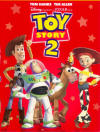 Toy Story 2
(1999) A few blocks away from where we used to live on Belmont
Street in
Portland, Oregon, there is one of the oddest museums I’ve ever
seen. It’s Kidd’s
Toy Museum, and it is housed more or less in an auto parts and
repair shop. You would never find it if you didn’t know what you
were looking for. Part of it is on one side of the street, and part
is in another building, sort of stashed in different rooms. The
shelves are absolutely jammed with mint-condition toys from the
1860s to the 1930s, with a few newer than that. There are all sorts
of toys, but the real glory is the mechanical banks. Kidd may have
the best collection of mechanical banks in the world. (Some of them
are appalling, such as a dozen “Jolly Nigger” banks, a very popular
item around the turn of the century.) What the entire collection is
worth is hard to say, but judging from the prices we’ve seen on “Antiques
Roadshow” for similar items, it is sure to be many millions.
Toy Story 2
(1999) A few blocks away from where we used to live on Belmont
Street in
Portland, Oregon, there is one of the oddest museums I’ve ever
seen. It’s Kidd’s
Toy Museum, and it is housed more or less in an auto parts and
repair shop. You would never find it if you didn’t know what you
were looking for. Part of it is on one side of the street, and part
is in another building, sort of stashed in different rooms. The
shelves are absolutely jammed with mint-condition toys from the
1860s to the 1930s, with a few newer than that. There are all sorts
of toys, but the real glory is the mechanical banks. Kidd may have
the best collection of mechanical banks in the world. (Some of them
are appalling, such as a dozen “Jolly Nigger” banks, a very popular
item around the turn of the century.) What the entire collection is
worth is hard to say, but judging from the prices we’ve seen on “Antiques
Roadshow” for similar items, it is sure to be many millions.
This is the direction the wonderful sequel to Toy Story takes. It turns out that Woody was a very popular television string puppet in the early ‘50s. He wasn’t aware of this until he lands in the hands of an unscrupulous collector who has every Woody item ever produced except a mint condition Woody himself. Woody is delighted to see this amazing collection: “I’m on a yo-yo!” He watches one of his old shows, fascinated and amazed. This is so wonderfully done, funny and touching. It took me back to the days when we watched Howdy Doody and his sister Heidi, friends Clarabell, Dilly Dally, Flub-a-Dub, Princess Summerfall Winterspring, and mean Mr. Bluster. (“Say kids, what time is it?” And the Peanut Gallery would shout back, “It’s Howdy Doody Time!”) He’s going to be shipped off to a museum in Japan where he will spend the rest of his life behind glass, never being played with. He eventually agrees with this idea, because he’ll be with his partners Jessie the Yodeling Cowgirl, Stinky Pete the Prospector (who’s never been removed from his box), and his faithful horse, Bullseye … but mostly because Jessie tells him the heartbreaking story of how she was abandoned by Emily, her owner, who grew up and put aside childish things. As we all do … except collectors.
This story resonated with me in many ways, at least partly because for about 15 years I collected toy robots. I never had any of the ultra-valuable Japanese ones from the ‘60s (though I’m pretty sure Granddaddy sold a bunch of them; oh, my, whatever happened to them?), but I had over 1000 before I sold them all off on eBay. I had everything from tiny rubber robots with parachutes to stuffed plush toy robots to giant plastic behemoths that shot three different kinds of projectiles, not unlike the Evil Emperor Zurg in this movie. What? So that makes me a bad guy? Well, I never kept any robot in its box, even though I knew that de-crating it lowered its value. And I did play with them, okay? Ask anyone who attended my monthly parties in Eugene. We played with them all the time. I can’t tell you how it tickles me to think of this legion of robots coming to life and acting out action scenarios when I was out of the house.
There are too many wonderful scenes to recount, but three stand out. First, when Buzz enters the toy store and discovers the Buzz Lightyear aisle, with a thousand copies of himself. Whoa! Imagine yourself in that situation. Then there is the wonderful recreation of a ‘50s TV adventure, way beyond low-budget, just like they were in those days. And you know what? I’ll bet children of my era were just as entertained by those primitive shows as today’s kids are by the high-tech, very expensive stuff they get these days. But most of all it is the sequence that shows Emily growing up and abandoning Jessie under the bed among the dust bunnies, and finally leaving her in a box by the charity bin … I was genuinely moved, which seldom happens in a cartoon. It was an early sign of the real emotion Pixar films could generate with things like the opening ten minutes of Up. Nobody but Disney in his heyday has done that to me. Bravo! IMDb.com
 Toy Story 3
(2010) And so we come to the end of the saga of Woody, Buzz, and all
their fiber and plastic friends, who endure the oddness of
collapsing lifelessly whenever a human being is observing them—you
think it’s a quantum mechanical phenomenon?—so they can enjoy being
loved and played with, sometimes pretty roughly, by the children
they love. In 1 and 2 this was Andy, but
he’s almost grown up now, heading off for college. What to do with
all these toys? Attic, daycare center, yard sale, or (gasp!) the
dreaded City Dump. Andy’s going to take Woody, but mix-ups ensue,
and they all end up at the daycare center. At first it’s Sunnybrook
Farm, but when the lights go out … it’s more like
Stalag 13,
complete with fuzzy, strawberry-smelling, not at all comical Colonel
Klink in the form of Lots-O’-Huggin’ (“Call me Lotsa”), a big pink
stuffed bear. So we get a prison break movie, and the break is
ingenious.
Toy Story 3
(2010) And so we come to the end of the saga of Woody, Buzz, and all
their fiber and plastic friends, who endure the oddness of
collapsing lifelessly whenever a human being is observing them—you
think it’s a quantum mechanical phenomenon?—so they can enjoy being
loved and played with, sometimes pretty roughly, by the children
they love. In 1 and 2 this was Andy, but
he’s almost grown up now, heading off for college. What to do with
all these toys? Attic, daycare center, yard sale, or (gasp!) the
dreaded City Dump. Andy’s going to take Woody, but mix-ups ensue,
and they all end up at the daycare center. At first it’s Sunnybrook
Farm, but when the lights go out … it’s more like
Stalag 13,
complete with fuzzy, strawberry-smelling, not at all comical Colonel
Klink in the form of Lots-O’-Huggin’ (“Call me Lotsa”), a big pink
stuffed bear. So we get a prison break movie, and the break is
ingenious.
All through this movie, as in the others, there is wit and zany ideas. Mr. Potato Head always seems to have the worst of it. He has been robbed of his body, but he manages to attach all his body parts to a tortilla. Now he’s Mr. Taco Head, and it’s a soft taco. Just trying walking as a limp tortilla which a pigeon has his eye on. He is banished to “the box” in a scene taken right out of Cool Hand Luke. He returns and reports it was full of sand, nothing else in there but a couple of Lincoln Logs. He is told “I don’t think those were Lincoln Logs …” But Buzz has his share of troubles, too. The problem when you’re an electronic toy is that you can be reprogrammed. They accidentally activate the Spanish-language option, and he becomes the Latin lover who dances the flamenco and seduces Jessie the Cowgirl.
There is boisterous action, but never so frantic you don't know exactly what’s happening. On a technical level it is as good as or better than anything I’ve seen lately, particularly in the climactic scenes when everybody is trapped in a monstrous garbage dump. My, my, how far we have come in 15 years. Toy Story, while still wonderful to look at, was CGI 101. We’re now in post-doctoral studies when it comes to what they can show, which is, bottom line, anything at all.
But any of the above could describe just about any CGI cartoon these days. This is a Pixar film, which means they aren’t afraid to show situations that are genuinely emotional, not just trumped up adventures by standard plug-in characters. There are themes here that will resonate with children and adults alike. The last thing I expect in an animated movie is to be all teary-eyed at the end … but I was. Aside from Up, that hasn’t happened to me since the classic Disney days.
As always, the feature is paired up with a short cartoon. This is a really ingenious one called “Day and Night.” Why is it that it takes an animation company to bring back the tradition of having a cartoon with the feature movie? I guess I’ve answered my own question. It’s because only animators respect the medium that much. But would it be so damn hard to pair an animated short with a live-action comedy? There are literally thousands of good shorts out there, and they get almost no distribution at all. Would you have minded if, say, The Hangover had started out with a Mickey Mouse, or a Bugs Bunny, or a Roger Rabbit? Except, of course, these days the short might be a lot funnier than the movie … IMDb.com
